|
A selection of recordings (1900-1980)
ALSEN Elsa - German 1880-1975
 Born in West Poland from a French mother and a Norwegian father. Sang in Berlin and Chicago. Born in West Poland from a French mother and a Norwegian father. Sang in Berlin and Chicago.
Records: Two 'Liebestod', two Götterdämmerung (complete), 1928.
Isolde: Liebestod, accompanied by anonymous orchestra, 1932 (National Sound Archive, London, n° EJS 444, pirate). For a complete discography of Tristan see appendix.
Voice in place from the very beginning of 'mild und leise' with presence of the low tones. A certain ability to move, which allows growing dramatic tension, but Elsa Alsen who seems to approach the central difficulty solidly on pitch, is suddenly carried away by the wave, before disappearing completely in terms of vocal emission as well as from the actual grooves of the record.
ALTMEYER Janine - American
 Pupil of Lotte Lehmann in Santa Barbara, Met Award of the Year. Début Met: First Lady in The Magic Flute, first Flower Maid in Bayreuth; sings Sieglinde (Die Walküre) in Bayreuth in 1976. Pupil of Lotte Lehmann in Santa Barbara, Met Award of the Year. Début Met: First Lady in The Magic Flute, first Flower Maid in Bayreuth; sings Sieglinde (Die Walküre) in Bayreuth in 1976.
Isolde: Bayreuth, 25th July 1986; Festival Orchestra, cond. Daniel Barenboim.
Unconnected vocal registers, breaks away towards the high range; obliterates the ends of phrases; voice constantly out of balance; surrounded by a romantically pathetic halo of doubtful taste. An ever-present staccato negates Wagner's musical intention. Cannot lift her voice up in the lower medium, and consequently eliminates the finale of Tristan. Hides behind the reputation of a prestigious teacher who, herself, had never sung Isolde nor even the Countess in The Marriage of Figaro. The feathers are far more beautiful than the song: compensation for the poor listeners at Bayreuth or elsewhere?
AUSTRAL Florence - Australian 1894-1968, Newcastle
 Career and life in Australia, Great Britain and the USA. Like Melba, her stage name evokes her native country. Preferred Covent Garden to the Met. Début in Die Walküre (Brünnhilde), and in Der Ring des Nibelungen (Brünnhilde, a part she sings alternately with Frida Leider). Career and life in Australia, Great Britain and the USA. Like Melba, her stage name evokes her native country. Preferred Covent Garden to the Met. Début in Die Walküre (Brünnhilde), and in Der Ring des Nibelungen (Brünnhilde, a part she sings alternately with Frida Leider).
Isolde: With the British National Opera Company in London. Sound recording HMV; extracts from the Ring.
Recording not available at the present time.
BALANOWSKAYA Leonida Nikol'yevna - Russian 1883-1960
 Born near Kiev. Her father was an accountant who died early. 1902: St Petersburg Conservatoire. 1906: Kundry (Parsifal, first performance in Russia). La Gioconda, Les Huguenots. Sang in Kiev, then worked in the Bolshoy Theatre. Toured France, England, Austria (Wagnerian repertoire), then the Far East (1924-1925). Professor at the Moscow Conservatoire and at the Bolshoy Theatre. Died in Moscow. Born near Kiev. Her father was an accountant who died early. 1902: St Petersburg Conservatoire. 1906: Kundry (Parsifal, first performance in Russia). La Gioconda, Les Huguenots. Sang in Kiev, then worked in the Bolshoy Theatre. Toured France, England, Austria (Wagnerian repertoire), then the Far East (1924-1925). Professor at the Moscow Conservatoire and at the Bolshoy Theatre. Died in Moscow.
Isolde: 80 T Pathé 22179 - Moscow 1913.
Monochromatic delivery without differentiation between the levels of the work as a whole which is left lifeless. Rectilinear and syllabic song in the manner of Felia Litvinne. High notes escape towards the back; she cannot sustain the line. Does however stress the B of 'Atems'. In the passage: 'in dem wogenden Schwall, in dem tönenden Schall' the tempo increases abruptly which makes the voice 'hop' (is this due to the recording?). Because of the beauty of her timbre, the 'höchste Lust' maintained for a long time from forte to pianissimo would constitute a grandiose ending, were it not underlined by a most surprising glottal stop.
BALGUERIE Suzanne - French 1888-1973
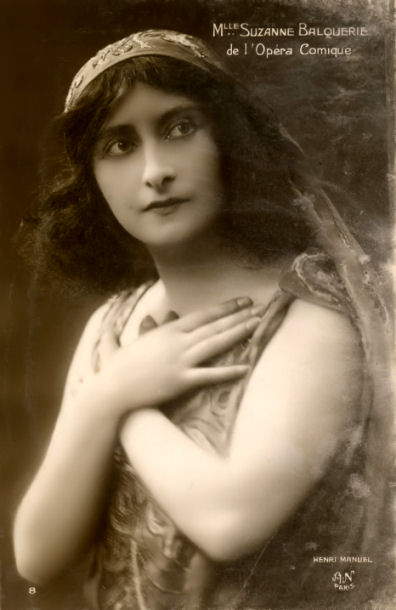 Sings Isolde only at the Opéra Comique from 1920 to 1931 approximately (perhaps also in Lyon?). Brünnhilde in 1923 at the Paris Opéra. Famous Pénélope, Ariane (Dukas), Donna Anna, Elsa, Marguerite. Interpreter of contemporary music (Milhaud, Satie, Fauré, Poulenc). Sings Isolde only at the Opéra Comique from 1920 to 1931 approximately (perhaps also in Lyon?). Brünnhilde in 1923 at the Paris Opéra. Famous Pénélope, Ariane (Dukas), Donna Anna, Elsa, Marguerite. Interpreter of contemporary music (Milhaud, Satie, Fauré, Poulenc).
Makes her début as a dancer (ballet of A. Roussel: Le Marchand de sable qui passe).
Isolde: Polydor 1929, Orchestre Lamoureux, cond. Albert Wolff.
Technique of the Thirties. Pretty, well-articulated words, but without lyricism. The voice lacks deep resonances. Literal understanding of a work which is rendered in over-accented syllables.
Lack of brio and shine in this Isolde of the Opéra-Comique. In French. Orchestra of no account.
BALSLEV Lisbeth - Danish
 Studies: at the Vestjysk Conservatorium, Esbjerg. Enters the Opera School of the Royal Studies: at the Vestjysk Conservatorium, Esbjerg. Enters the Opera School of the Royal
Theatre, Copenhagen. In 1977, member of the regular troupe; sings Mozart: Cosi Fan Tutte, Die Zauberflöte (Queen of the Night), Il Trovatore (Leonora) and The Flying Dutchman (Senta).
1978: Senta at Bayreuth. 1979, Hamburg Opera: Elsa. At Munich, Iphigenia in Tauris (Gluck).
Isolde: Radio recording.Teatro comunale of Florence, 1988, Orchestra of Florence, cond. Gustav Kuhn.
Gruff voice with close tremolo which cannot sing the G sharps of the gruppetti; breath too short to reach the E of 'klinget'. In search of her basis of emission between the middle C and the G, the Wagnerian fifth par excellence; dodges the central part where the low tones are no longer sustained. 'Welt-Atems' cried out, B non-existent; timbre in 'Lust' which seems to fall from the flies. A legato style ignored by the singer as well as by the Salzburg conductor, a disciple of Karajan.
BARLOW Klara - English
 Isolde: In the US LP Saga (G.B.) LR 152, private. Recording not available. Isolde: In the US LP Saga (G.B.) LR 152, private. Recording not available.
BAUMANN Paula - German
 Sang Senta in 1942 and Brünnhilde. Career interrupted in the 1950s. Sang Senta in 1942 and Brünnhilde. Career interrupted in the 1950s.
Isolde: Complete Tristan und Isolde in Vienna (recently published recording); NWDR Orchestra, cond. Hans Schmidt-Isserstedt (16-12-1949).
Voice of size; debut as a mezzo in concert, then dramatic soprano. Is unable to hold the line and therefore cannot sing piano in spite of a deep interior 'yawn'. The high tones do not open outward. The lower medium and the vowels remain in a grisaille. She has neither the solidity nor the clarity of her preferred partners, Margarete Klose and Max Lorenz.
BÄUMER Margarete - German 1898-1969
 Studies Düsseldorf, Köln. 1928 : Berlin, Prague, Riga. 1933 : Kundry. 1936 : Senta, Venus, Isolde. Studies Düsseldorf, Köln. 1928 : Berlin, Prague, Riga. 1933 : Kundry. 1936 : Senta, Venus, Isolde.
Isolde: Gewandhaus Leipzig, cond. Franz Konwitschny. Urania 1943-44, published 23-10-1950 in Leipzig. Complete Tristan with Ludwig Suthaus, Erna Westenberger. Did not sing in Bayreuth.
Vocal colour and dramatic intensity reasonably genuine to the extent that she goes to the ends of her phrases by using the 'grain' of the voice, and this in spite of sometimes excessive stressing. Sings desperately, with emotion, including G sharp, without sinking into the surf of the waves. The B is partly reached. Commits herself resolutely, but we are left with an impression of patchwork.
BEHRENS Hildegard - German
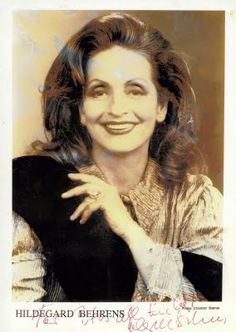 Studied law. Opera Studio (Düsseldorf); Marie (Wozzeck), Salome (chosen by Karajan for EMI) Salzburg Festival (1977), Metropolitan Opera (Il Tabarro by Puccini), Munich (Fidelio, cond. Karl Böhm), Isolde in Zurich and Munich (cond. Sawallisch). Studied law. Opera Studio (Düsseldorf); Marie (Wozzeck), Salome (chosen by Karajan for EMI) Salzburg Festival (1977), Metropolitan Opera (Il Tabarro by Puccini), Munich (Fidelio, cond. Karl Böhm), Isolde in Zurich and Munich (cond. Sawallisch).
Isolde: 27th July, 1980, Munich, cond. Wolfgang Sawallisch, radio recording.
Intelligent use of the high middle register by a voice remaining light, without body and indefatigable. The instrument (it is one) does not have the colouring of the Wagnerian medium.
Seeks out the perfect note at the expense of the general colour. This 'Liebestod' provoked a surging reaction on the part of the Munich audience, the city where Tristan was born.
BINDERNAGEL Gertrud - German 1894-1932
 Dramatic soprano: Wagnerian parts (invited to Barcelona, Munich, Hamburg, Mannheim, Vienna, Berlin). Dramatic soprano: Wagnerian parts (invited to Barcelona, Munich, Hamburg, Mannheim, Vienna, Berlin).
Isolde: Berlin Philharmonic Orchestra, cond. Selmar Meyrowitz, 1930.
The Philharmonic Orchestra creates the Wagnerian climate; however, problems of interpretation are caused by grandiloquence, veiled tones, sunken and strained towards the back, and a diction rendered difficult under these conditions of emission; we are left with the impression of a lack of youth, and a sadness which obstructs the light of transfiguration.
BJÖNER Ingrid - Norwegian
 Studies at Oslo Conservatory and Frankfurt Hochschule für Musik. 1960 début in Bayreuth (Freia, Gutrune), debut Met (Elsa), Covent Garden (Elsa in 1967), Wagnerian parts from Senta to Brünnhilde. Studies at Oslo Conservatory and Frankfurt Hochschule für Musik. 1960 début in Bayreuth (Freia, Gutrune), debut Met (Elsa), Covent Garden (Elsa in 1967), Wagnerian parts from Senta to Brünnhilde.
Isolde: Radio recording, Vienna Opera 1971, cond. Horst Stein.
Voice sounding somewhat 'grainy', tempo slow with a sense of grandeur; very fleshy vibrato which, in the midrange, prevents the approach to high notes ('immer lichter wie er leuchtet') where she is submerged by the tumult of the orchestra. This light, slightly nasal voice with fairly easy high tones 'progresses' only in a succession of static phrases.
BOLOTINE Minna - Belgian 1901-1966
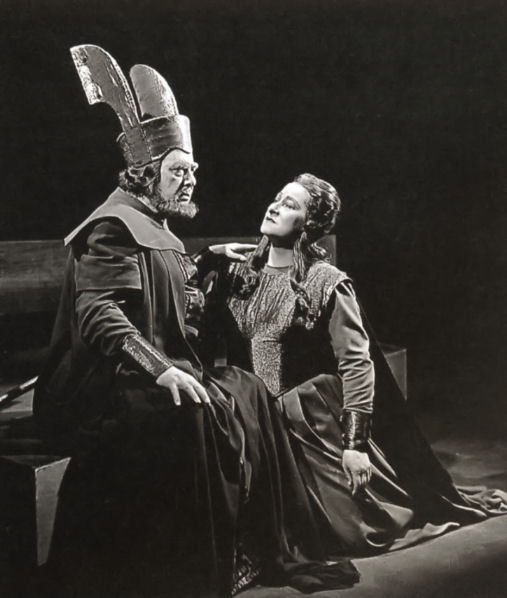 Used to sing in Antwerp and in Germany. Used to sing in Antwerp and in Germany.
Isolde: Record Vox stereo. Cond. Robert Wagner 1962.
At first mezzo, then dramatic soprano. Conscious of the quality of her voice, she tries to avoid the problems by a rather (if not too) lively start, but the uncontrolled vibrato of a sagging
intonation obliges her to precipitate her delivery, and to exteriorise - like a Verdian voice - by squeezing the timbre to overflowing. A general mist covers this interpretation.
BRAUN Helena - German
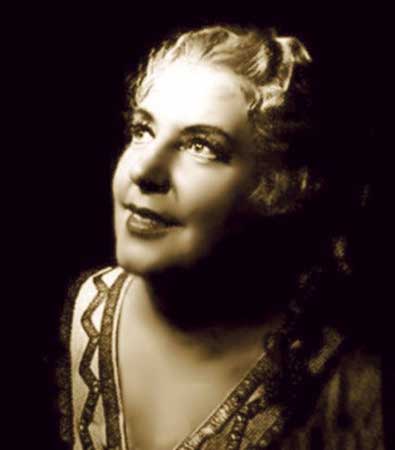 Sang mainly in Munich (Leonore in Fidelio, Ortrud, Brünnhilde), Vienna and Italy. Married to the bass-baritone Ferdinand Frantz who was among the last to sing Wotan under Furtwängler; the latter did not invite H. Braun as would have been usual, but preferred Martha Mödl. Sang the Countess (Le Nozze di Figaro) in 1942, Ortrud in 1959 (Munich). Sang mainly in Munich (Leonore in Fidelio, Ortrud, Brünnhilde), Vienna and Italy. Married to the bass-baritone Ferdinand Frantz who was among the last to sing Wotan under Furtwängler; the latter did not invite H. Braun as would have been usual, but preferred Martha Mödl. Sang the Countess (Le Nozze di Figaro) in 1942, Ortrud in 1959 (Munich).
Isolde: Radio recording (May 1950) Munich, Orchestra of the Bavarian State Opera, cond. Hans Knappertsbusch.
Wagnerian singer 'on duty' in Bayreuth from 1965 to 1971. Why choose a coloratura soprano who, what is more, has problems mastering the high register? From the beginning the voice hesitates, trembles, and is unsure in its entries; she exhausts her breath in search of expression.
Has, however, a certain expressiveness in the timbre. The orchestra, fully present, underlines this parody with operetta accents.
BREVAL Lucienne - Swiss-German, naturalised French 1869-1935
 Berthe Agnès Lisette Schilling. Studies in Geneva. Début in Paris in 1892 (Selika in L'Africaine). Creates Griselidis (1901) and Pénélope. 1893: Brünnhilde (Die Walküre), 1897: Berthe Agnès Lisette Schilling. Studies in Geneva. Début in Paris in 1892 (Selika in L'Africaine). Creates Griselidis (1901) and Pénélope. 1893: Brünnhilde (Die Walküre), 1897:
Eva (Die Meistersinger von Nürnberg) and Marguerite (La Damnation de Faust by Berlioz).
1895: Venus (Tannhäuser). In 1906 she refuses to sing Brünnhilde (Die Walküre) at the request of Cosima Wagner. The latter chooses Louise Grandjean for the première of Siegfried and Götterdämmerung in Paris. 1913: Pénélope by Fauré.
Isolde: Recording not available.
BUCHNER Paula - Austrian 1900-1963
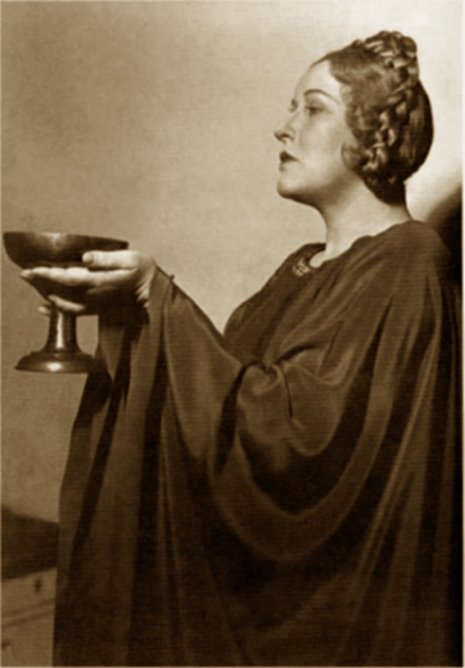 Career in Berlin, Munich, Vienna. Isolde with Germaine Lubin in Bayreuth (1938-39). Kundry in Bayreuth. Brünnhilde in Bayreuth (1942). Career in Berlin, Munich, Vienna. Isolde with Germaine Lubin in Bayreuth (1938-39). Kundry in Bayreuth. Brünnhilde in Bayreuth (1942).
Isolde: Radio Berlin 1942, performance of the State Opera, cond. Robert Heger.
Does the part of Isolde suit this artist who sings at the top of her voice with a resounding sensuous timbre, pouring forth rather long phrases? Does it suit this unbridled voice which speeds up delivery and pushes us with a certain amount of ungainly singing to the final 'Lust' which is powerfully given, held for a long time, wiping out the aspect of radiance in the Wagnerian character?
BUNLET Marcelle - French
 1926: Début in Paris. 1928: Brünnhilde (Götterdämmerung), then Théâtre de la Monnaie, Brussels. 1931: Chosen by Toscanini to be Kundry in Bayreuth. 1934: Teatro Colón (Buenos Aires). 1935: French version of Arabella in Monte Carlo. Sings in Strasbourg. Career into the 1950s. The great French Wagnerian singer of her time together with Germaine Lubin. 1926: Début in Paris. 1928: Brünnhilde (Götterdämmerung), then Théâtre de la Monnaie, Brussels. 1931: Chosen by Toscanini to be Kundry in Bayreuth. 1934: Teatro Colón (Buenos Aires). 1935: French version of Arabella in Monte Carlo. Sings in Strasbourg. Career into the 1950s. The great French Wagnerian singer of her time together with Germaine Lubin.
Isolde: Recording not available.
CABALLE-MONTSERRAT - Catalan
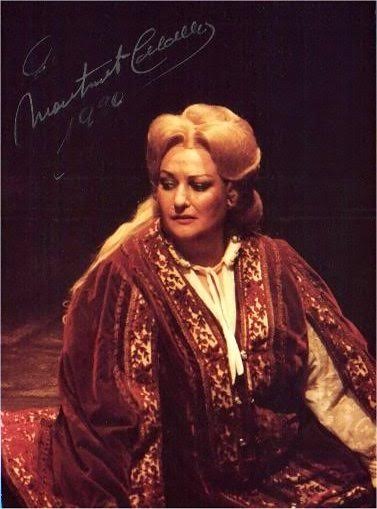 Studies at the Liceo Conservatory, gold medal in 1954. Début: Basel, Bremen, Mexico. At the Metropolitan Opera: Faust (1965) and La Traviata (1967). Norma (Orange, 1974). Tosca (Met Opera, 1979). Studies at the Liceo Conservatory, gold medal in 1954. Début: Basel, Bremen, Mexico. At the Metropolitan Opera: Faust (1965) and La Traviata (1967). Norma (Orange, 1974). Tosca (Met Opera, 1979).
Isolde: CBS 37294, New York Philharmonic Orchestra, cond. Zubin Mehta
Is her impact on part of the contemporary audience perhaps due to an emission related to that of what Richard Wagner called the 'female castrati' (focalisation in the head resonances, supple lightness and impression of diaphanous character)? All this, of course, incompatible with the real legato phrasing and the balanced harmonics (high and low).
Here, this pseudo-emission - which is deceptive - ignoring all the difficulties: tempo, diction, legato, homogeneity in the tessitura, high notes, gruppetti, style, reaches a culminating point as far as the incomprehension of the 'Liebestod' is concerned. The drakkar piercing the mist of the Irish Sea for the sake of Tristan has been turned into flotsam by'Cloacina, goddess of the tide
Whose sable streams beneath the city glide'.
CALLAS Maria - Greco-American 1923-1977
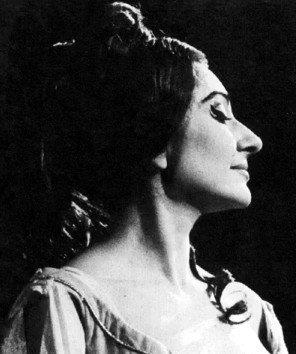 Sang Brünnhilde (Die Walküre) and I Puritani within a few days of eath other in the years 1948-49 in Italy (Fenice). Sang Brünnhilde (Die Walküre) and I Puritani within a few days of eath other in the years 1948-49 in Italy (Fenice).
Isolde: (In Italian), Isotta, December 1949; RAI Orchestra, Torino, cond. Arturo Basile.
From the beginning, the voice rises, nostalgic and clear, slightly from the chest in the lowest reaches of the music, before deliberately engaging in 'bel canto'. Her gruppetti belong to the coloratura and the singer handles crescendi and effects with great care until she obtains bright G sharps, sorrowfully struck in the timbre. Tempo somewhat slowed down in the medium of the central part, last note less happy, even if held out for a long time. Lurid interpretation of a tragedian, projected audibly over the orchestra despite her youth. In fact, nearer to the character than has been admitted so far.
COBELLI Giuseppina - Italian 1898-1948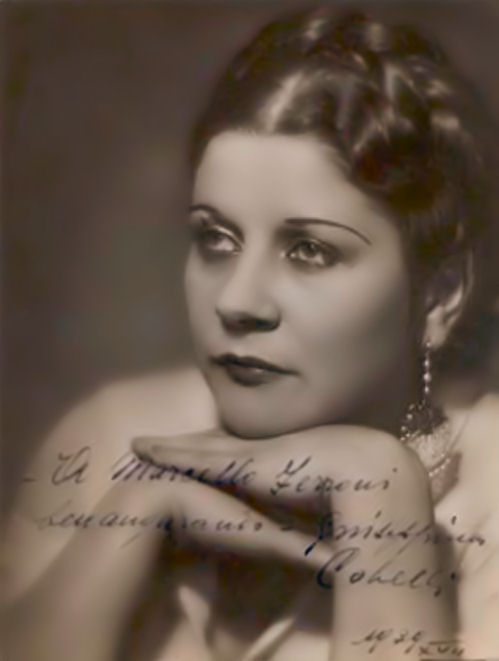
Soprano. Debuts 1924 (La Gioconda). 15-11-1925: Sieglinde (Die Walküre) at the Scala. In Milan she is admired as Isolde and Kundry whom she sings at the same time as La Fanciulla del West and Mefistofele until 1942. Invited to the Colón Theatre (Buenos Aires). Toscanini entrusts her with the part of Eboli (Don Carlo) at the Scala in 1926.
Isolde: At the Scala of Milan, with Giuseppe Borgatti.
Recording not available. Two records (HMV) + CD Symposium 1102.
CORSI Emilia - Italian 1870-1927
 Début 1886, Micaëla in Bologna, then I Puritani, Gilda, Rosina, Lucia. From 1898, she grapples with the verismo repertoire (Manon Lescaut, I Pagliacci, La Gioconda), and also Sieglinde. Becomes dramatic soprano, interprets Wagner, then sings Agathe and The Queen of Spades at the end of her career. Invited to Odessa, Kiev, St Petersburg, Warsaw. Début 1886, Micaëla in Bologna, then I Puritani, Gilda, Rosina, Lucia. From 1898, she grapples with the verismo repertoire (Manon Lescaut, I Pagliacci, La Gioconda), and also Sieglinde. Becomes dramatic soprano, interprets Wagner, then sings Agathe and The Queen of Spades at the end of her career. Invited to Odessa, Kiev, St Petersburg, Warsaw.
Isolde: Odeon 110165-66 (1910).
Exteriorised singing-technique in the Italian way, with a voice slightly hollow in the vital lower reaches. Projects with vehemence and harshness. Chooses not to respect the music in the triplets ('in dem wogenden Schwall'). The F sharp of 'Lust' is vigorously sung, first mezzo-forte, then piano. A ready-made production that has little to do with Wagner.
CRESPIN Régine - French
 Début 1950, Mulhouse: Elsa. 1951, Paris Opéra: Elsa. Bayreuth (1958), Glyndebourne (1959), Covent Garden (1969), Met (1962), Aix-en-Provence and San Francisco (1966), etc. Début 1950, Mulhouse: Elsa. 1951, Paris Opéra: Elsa. Bayreuth (1958), Glyndebourne (1959), Covent Garden (1969), Met (1962), Aix-en-Provence and San Francisco (1966), etc.
Isolde: Dreamt of singing Isolde: Le Rêve Passe! (The Dream Passes); see also our letter to Harold Rosenthal (in Lettres Carrées à la Maison Ronde et à quelques Octogones).
DEMOUGEOT Marcelle - French 1876-1931
 Jeanne Marguerite Marcelle Decorne. Début 1902: Donna Elvira (Don Giovanni). 1911: Fricka. Jeanne Marguerite Marcelle Decorne. Début 1902: Donna Elvira (Don Giovanni). 1911: Fricka.
1914: Kundry (Parsifal). 1930: Brünnhilde (Strasbourg).
Isolde: Recording not available.
DERNESCH Helga - Austrian
 Studies in Vienna. Début in Berne in 1961 (Fiordiligi). 1967: Elisabeth in Bayreuth; 1968: Eva. Studies in Vienna. Début in Berne in 1961 (Fiordiligi). 1967: Elisabeth in Bayreuth; 1968: Eva.
From 1969, Brünnhilde and Isolde on the stage and on record.
Isolde: 1972 EMI Records; Berlin Philharmonic Orchestra, cond. Herbert von Karajan.
Having gone through an entire Wagner repertoire, this voice has been used too much. The orchestra engorges what little tone she has. The perplexity one feels from the very beginning while listening to this timbre which hesitates to enter the resonances, is quickly transformed into an ever-growing irritation faced with a dignity which is as short-measured as her vocal expression, speeding things remorselessly or pulling the high notes from the bottom of an emission which is far too 'yawned'.
DESTINN Emmy - Czechoslovakian 1878-1930
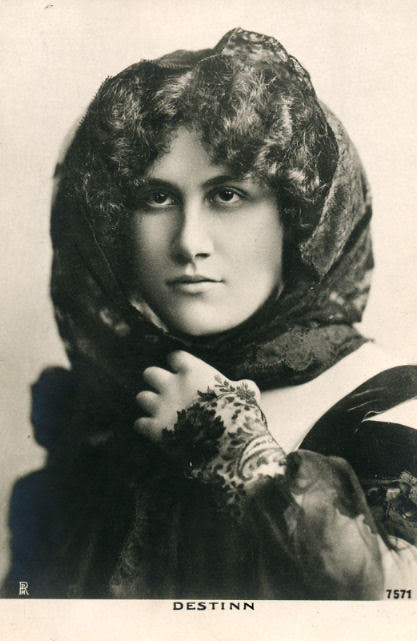 Was the first Senta in Bayreuth in 1901. Sang Aïda, Butterfly, Santuzza, Carmen, Marguerite. Was the first Senta in Bayreuth in 1901. Sang Aïda, Butterfly, Santuzza, Carmen, Marguerite.
Sang with Caruso (La Fanciulla del West, 1910).
Isolde: Gramophone 1910, with orchestra.
Voice with a wide range but poorly placed and that, in this case, looks for an imaginary height, thus producing glissandi, portamenti, high pizzicati, thinned out or uncontrolled; medium inflated on the verge of precision, cannot be relied on to produce the pianissimi. Yet, there is something spicy in the 'grain' which hangs on to the orchestra, but turns out to be detrimental to the final 'Lust' which is of an almost threatening colour.
DVORAKOVA Ludmilla - Czechoslovakian
 Laureate of the Dubrovnik Contest in 1948. Prague Conservatory. Concert on French Radio in 1948. 1954: Senta. In Bayreuth from 1965 to 1971. Sang Venus, Brünnhilde, Ortrud, Kundry, Isolde. Début as Isolde in Karlsruhe in 1963. Laureate of the Dubrovnik Contest in 1948. Prague Conservatory. Concert on French Radio in 1948. 1954: Senta. In Bayreuth from 1965 to 1971. Sang Venus, Brünnhilde, Ortrud, Kundry, Isolde. Début as Isolde in Karlsruhe in 1963.
Isolde: Prague Orchestra, cond. Rudolf Vosata. Supraphon 802432R (1967).
Vocal opulence stagnating in a motionless interpretation, pompous, monumental, exaggeratedly slow tempo. In spite of the thickening of the resonances, all notes are produced with glottal stops in the medium as an addition to the programme. The high register is nobly sustained, as in the final phrase, but the performance lacks youth, if not simply life.
EASTON Florence - English 1884-1955
 Soprano. Studied at the RCM, London, and Paris. Debut with Moody-Manners Co. Soprano. Studied at the RCM, London, and Paris. Debut with Moody-Manners Co.
Engagements in Berlin 1907-13 and Hamburg 1914-16. Met 1917-29 (US première of Gianni Schicchi). 100 parts, among them Brünnhilde, Isolde, Tosca, Turandot, Carmen. 1932: Isolde at Covent Garden.
Isolde: 1942, only version in English, radio orchestra.
Sings with commitment and a marked diction, stiff and jerky. A clear voice where neither breathing nor deep harmonics are under control. Translation of the 'Liebestod' into English by herself.
FARRELL Eileen - American
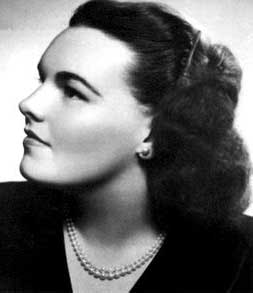 1960: Belongs to the company of the Met and sings at the Opera Houses of Rome, Chicago, San Francisco. Brünnhilde and Isolde in concert. 1960: Belongs to the company of the Met and sings at the Opera Houses of Rome, Chicago, San Francisco. Brünnhilde and Isolde in concert.
Isolde: New York Philharmonic (25-3-1951), cond. Victor de Sabata.
Incarnates the dignity of what some people call a Wagnerian voice. Looks for the low harmonics throughout, worries about it, narrows her throat and thins immediately, interrupts the line in order to save breath and power, indulges herself in the G sharps which she renders destroying the 'grain' of her voice, and finishes the phrases discolouring somewhat. In order to hold out against a powerful, lively and ponderous orchestra, she declaims and labours away, pedestrian. Incarnates perhaps a Queen, but not the Princess of Ireland and her transfiguration.
FLAGSTAD Kirsten - Norwegian 1895-1962
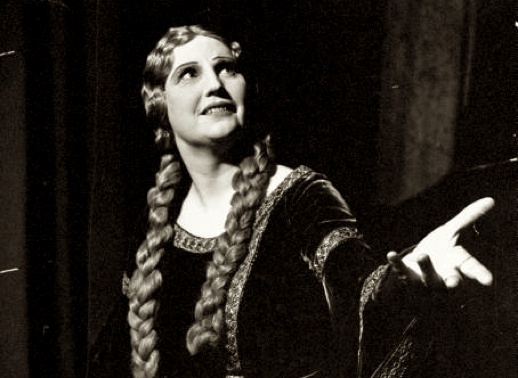 Début Isolde, Oslo 1932, Göteborg (Sweden) 1933. Small parts in Bayreuth: 1934 Sieglinde, Gutrune. 1935-41: At the Met, Sieglinde, Isolde, Brünnhilde, Elisabeth, Elsa, Kundry. 1941-45: In Norway. Début Isolde, Oslo 1932, Göteborg (Sweden) 1933. Small parts in Bayreuth: 1934 Sieglinde, Gutrune. 1935-41: At the Met, Sieglinde, Isolde, Brünnhilde, Elisabeth, Elsa, Kundry. 1941-45: In Norway.
Isolde: Covent Garden, radio recording (18-6-1937).
Loud, piercing voice, very much projected, straight singing-line, dominates the orchestra with matronal dignity (in accordance with the dipal interpretation in favour with Wieland Wagner?) but the singer remains aloof, Scandinavian, keeps a distance with respect to the passion which should carry her away. High tones sometimes held back which do not always harmonise with the Wagnerian surf; that does not stop Kirsten Flagstad from producing a good final F sharp (of which she was proud) mezzo forte and piano (and not pianissimo) with a nostalgia resigned rather than ecstatic: A predominantly literary blondness for this 'Isolde of the century'.
However, let us not depart from the Golden Legend!
FREMSTAD Olive - Swedish, then American 1871-1951
 Anna Augusta Olivia Petersen; originally a pianist. Salome in London with Beecham. Also Isolde, Brünnhilde, Kundry at the Met. For two years a pupil of Lilli Lehmann. 1896, Anna Augusta Olivia Petersen; originally a pianist. Salome in London with Beecham. Also Isolde, Brünnhilde, Kundry at the Met. For two years a pupil of Lilli Lehmann. 1896,
Bayreuth: Brangäne, Ortrud, Venus.
Isolde: Boston (1913) with orchestra.
Sings in tune, but does not arch her tone in space. This former mezzo turned dramatic soprano and then soprano is deprived of the mellowness of the voice. Should the character of Isolde as expressed by means of exacerbated shrieking tones, be understood avoiding the flow and surge of the middle section by a series of lapping wavelets?
 FUCHS Marta - German 1898-1974 FUCHS Marta - German 1898-1974
Début in 1928 as contralto. Career in concert, as a contralto and later as a soprano. In Bayreuth from 1933 to 1937: Isolde, Brünnhilde, Kundry. Takes the part of Isolde in turn with Frida Leider, in 1938. Isolde, Paris Théâtre des Champs-Elysées, 1938.
Isolde: Electrola 1938, cond. Bruno Seidler-Winkler.
Strong, warm voice with harmonics which occasionally strike a blow to the heart, warmly carried by the orchestra ('in dem wogenden Schwall, in dem tönenden Schall...'). The high tones are difficult, but the G sharp of 'Welt' is well sustained, even if it removes from the voice the suppleness necessary to render the final pianissimo. This lively execution more often than not lacks nobility, poetry or sensuality.
GADSKI Johanna - German 1872-1932
 Elsa at the Met in 1895. Covent Garden: 1898-1901, light Wagnerian parts. 1899: Eva in Bayreuth. 1900 at the Met: Senta, Brünnhilde, Isolde. Elsa at the Met in 1895. Covent Garden: 1898-1901, light Wagnerian parts. 1899: Eva in Bayreuth. 1900 at the Met: Senta, Brünnhilde, Isolde.
Isolde: 1907, 78 T, Victor.
High placement of the voice; its opening uncovers the glottis. Direct emission which does not sustain the final notes, resulting in low tones of insufficient timbre. Lack of breath and ability to sustain; rapid vibrato in places.
GALL Yvonne - French 1885-1972
 Eva (Paris Opéra, 1909), Lohengrin (1910). Also Mathilde (Guillaume Tell), Gilda, Thaïs, Desdemona, Valentine and Marguerite in Gounod's Faust (1934, 2000th performance, with Georges Thill, André Pernet, cond. Philippe Gaubert). Opéra Comique from 1921: Manon, Tosca, Louise, Ariane, Juliette and Donna Anna. Married to Henri Busser. Eva (Paris Opéra, 1909), Lohengrin (1910). Also Mathilde (Guillaume Tell), Gilda, Thaïs, Desdemona, Valentine and Marguerite in Gounod's Faust (1934, 2000th performance, with Georges Thill, André Pernet, cond. Philippe Gaubert). Opéra Comique from 1921: Manon, Tosca, Louise, Ariane, Juliette and Donna Anna. Married to Henri Busser.
Isolde: Pathé, Paris 1923.
'French' voice according to the terminology and perception of quality of the Swiss soundengineer Rolf Liebermann; a few rolled 'r's' in addition. Sings in French. Tempo too fast and insufficiently sustained. The voice, sometimes shrill, pierces through a distant or non-existent orchestral mass. Never quite determines what the rôle is about, cuts off the words 'Welt-Atems' between the G sharp and the B natural; sings 'Lust' fortissimo.
GORR Rita (Marguerite Grimaert) - Belgian
 Song Contest, Verviers 1946. Strasbourg 1949, 1952. Paris Opéra 1952. 1958: Bayreuth (Ortrud, Fricka), Milan, London. Naturally a mezzo who dealt with the parts of a dramatic soprano. Song Contest, Verviers 1946. Strasbourg 1949, 1952. Paris Opéra 1952. 1958: Bayreuth (Ortrud, Fricka), Milan, London. Naturally a mezzo who dealt with the parts of a dramatic soprano.
Isolde: Pathé Marconi 1959-1960. Cond. André Cluytens (VSM ASDF 141), Opera orchestra.
Did not dare accept the rôle on stage. Fine lyrical effort of this broad and colourful voice which, out of concern for expression, loses balance between the high and the low pitches. Calm execution with vocal stressing without real legato; worn by the accelerando and the agitato chosen by the conductor, because of the copiousness of the tone which makes the character appear like through a magnifying glass. Goes beyond the vocal limits in the bad sense of the word, and concludes with a happy-go-lucky 'Lust'.
GRAY Linda Esther - Scot
 Isolde, Welsh National Opera Orchestra, cond. Goodall; Decca D240D (five records), November 1980, and also in Bayreuth. Isolde, Welsh National Opera Orchestra, cond. Goodall; Decca D240D (five records), November 1980, and also in Bayreuth.
Isolde: Concert in Salle Pleyel, 5-02-1983, cond. Mathias Kunszch.
Has problems getting going. Sings breadthwise, sunken voice placed low, carefree vibrato ('Wonne klagend'). No depth, no contrasts in colouring, no differentiation with respect to levels.
The voice oscillates on the G sharps which, while being held, pass into the head, and fakes the final F sharp. Attempt at an all-lyrical interpretation from which emotions are supposed to be excluded: a tour de force in this connection.
GROB-PRANDL Gertrude - Austrian
 Sang Turandot, Donna Anna. A complete Tristan at the Scala in 1951 with De Sabata. Sang Turandot, Donna Anna. A complete Tristan at the Scala in 1951 with De Sabata.
Isolde: RAI concert 24-12-1953; de Fabritiis, Cetra LMR 5004.
After a placid beginning the voice held out with determination betrays nervousness and harshness in addition to poorly-controlled high tones. By permanent accentuation, a very exterior agitation and a too lively tempo the orchestra carries the singer away beyond
acceptable limits. After having botched up the climaxes 'in dem wogenden Schwall, in dem tönenden Schall' the singer indulges herself on 'unbewußt' and finishes on a 'Lust' forte, which is completely out of context. But was there ever a context in this kind of volumetric interpretation?
HAFGREN Lilly - Swedish 1884-1965
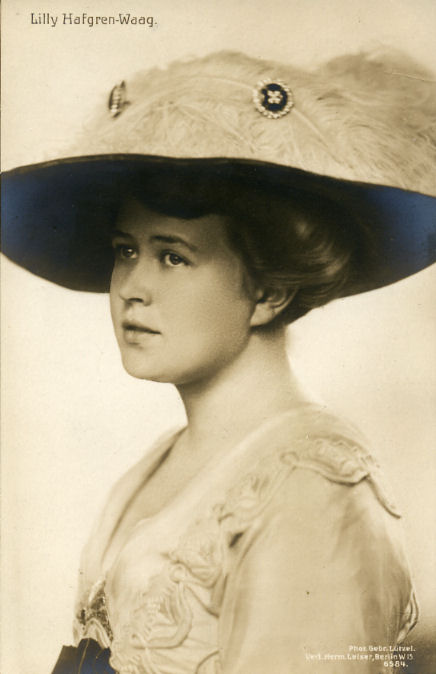 Originally a lyrical soprano who, after the First World War, specialised in the 'big' Wagner parts (Brünnhilde, Kundry), with a clear voice. Sang, in Bayreuth, Elsa and Eva before and after the War. Originally a lyrical soprano who, after the First World War, specialised in the 'big' Wagner parts (Brünnhilde, Kundry), with a clear voice. Sang, in Bayreuth, Elsa and Eva before and after the War.
Isolde: Odeon Orchester, Berlin 1921.
Tackles the 'big' Wagnerian heroines with the assets of Swedish blondness and clarity. Sang under Siegfried Wagner's direction. The voice loses some of its qualities as it progresses in the'Verklärung'. Sustains initially by depriving herself rashly of the harmonics, preserves for a time the line of song and of floating legato, but does not manage to set off the central crescendo.
Pulls on the high tones to the point of overlooking out any nobleness. Lack of breath obliges her to sing a syllabic and ridiculous 'Lust'.
HARSHAW Margaret - American
 Studies: Curtis Institute of Music. 1934: New York, Steel Peer Grand Opera. Sang first as a mezzo-soprano in Philadelphia. 2nd or 3rd Norn in the Ring and Waltraute. 1950-1951: Senta at the Met, then Brünnhilde (1952) and Kundry. Dramatic soprano who succeeded Helen Traubel as Wagnerian soprano. 1953-1956 and 1960, guest at Covent Garden; Brünnhilde in Bing's Ring. 1954, Glyndebourne Festival: Donna Anna (Don Giovanni). Since 1964, teacher at Bloomington (Indiana). A Brünnhilde (Die Walküre) in 1970. Studies: Curtis Institute of Music. 1934: New York, Steel Peer Grand Opera. Sang first as a mezzo-soprano in Philadelphia. 2nd or 3rd Norn in the Ring and Waltraute. 1950-1951: Senta at the Met, then Brünnhilde (1952) and Kundry. Dramatic soprano who succeeded Helen Traubel as Wagnerian soprano. 1953-1956 and 1960, guest at Covent Garden; Brünnhilde in Bing's Ring. 1954, Glyndebourne Festival: Donna Anna (Don Giovanni). Since 1964, teacher at Bloomington (Indiana). A Brünnhilde (Die Walküre) in 1970.
Recordings: Norma (duet with Zinka Milanov), Cavalleria Rusticana.
Isolde: Los Angeles Philharmonic Orchestra, cond. Bruno Walter, 1950.
The orchestra chooses an extremely slow tempo to suit the vocal specifications (broadened voice, open high tones, high medium non-existent) of a singer who solemnly listens to herself singing phrase after phrase. She has problems taking up the gruppetti and constantly shifts her vocal centre of gravity. The 'r's' are rolled so that a tired voice can hang onto them; she cuts off between the G sharp and the B of 'Welt-Atems', etc. Sounds the 'l' and the 't' of 'Lust' on a purely technical basis.
A church Isolde at compline, this 4th true-born American who sings Isolde at the Met (after Lillian Nordica, Helen Traubel and Jeanne Palmer), with R. Vinay (Tristan), B. Thebom (Brangäne), H. Hotter (King Marke). Conductor Fritz Stiedry, 1952-1953 Season.
HELM Anny - Austrian
 1927 to 1931 in Bayreuth, sang Venus and Brangäne. Settled in Italy in 1933. 1939: Venus in Covent Garden. Stopped singing in 1941. 1927 to 1931 in Bayreuth, sang Venus and Brangäne. Settled in Italy in 1933. 1939: Venus in Covent Garden. Stopped singing in 1941.
Isolde: In Rome in 1936, with Ebe Stignani singing Brangäne. Recording not available.
JERITZA Maria - Czechoslovakian 1887-1982
 Studied in Brno, Prague, New York. Eternal rival of Lotte Lehmann. Invited by Franz Josef to sing at the Vienna Opera in 1912. Very beautiful. Sang Turandot, La Fanciulla del West, Massenet, Strauss, Wagner in Paris, London, New York. Received longest ovation in New York as Tosca. Married three times. Studied in Brno, Prague, New York. Eternal rival of Lotte Lehmann. Invited by Franz Josef to sing at the Vienna Opera in 1912. Very beautiful. Sang Turandot, La Fanciulla del West, Massenet, Strauss, Wagner in Paris, London, New York. Received longest ovation in New York as Tosca. Married three times.
Isolde: Record Victor 1927.
Indisputable presence. Certain vibration and sensuality combined with clarity of timbre. Yet, the portamenti are not adequate to maintain the middle register at the desired level. Phrases at times interrupted by overtly dramatic singing. In the passage 'in dem wogenden Schwall' the artist chooses a lively movement, and in an entirely exterior panic carries the orchestra away. At this stage, Maria Jeritza does not dominate the part. In the low register and the piani, sustaining is insufficient. Cuts before the F sharp of 'Lust' in order to succeed better: example of lack of true sincerity.
JONES Gwyneth - Welsh
 Studied RCM, London; Accademia Chigiana in Sienna, Maria Carpi, Geneva. 1962-63: Zurich Opera, mezzo. 1964: Sieglinde (with Solti), Leonore, Senta. 1965: Isolde (23rd and 26th February at Paris Opéra). 1966: Bayreuth; La Scala, Milan. Other parts: Donna Anna, Tosca, Marschallin, Ortrud, Desdemona. Studied RCM, London; Accademia Chigiana in Sienna, Maria Carpi, Geneva. 1962-63: Zurich Opera, mezzo. 1964: Sieglinde (with Solti), Leonore, Senta. 1965: Isolde (23rd and 26th February at Paris Opéra). 1966: Bayreuth; La Scala, Milan. Other parts: Donna Anna, Tosca, Marschallin, Ortrud, Desdemona.
Isolde: Orchestre de la Société des Concerts du Conservatoire, cond. George Sebastian (broadcast by Radio France Musique: Autour de George Sebastian 29-08-1983).
Broken by the Wagnerian ebb and flow, Gwyneth Jones draws out the resonances in a slow narcissistic tempo, sliding into the high notes, magnifying the context, bearing down too hard on the phrase. This lack of tension indispensable for the interpretation of the 'Verklärung' prevents her from controlling her breath and from reaching the B natural of 'Atems'. A tremolo of seismic force bars the access to Valhalla.
JUYOL Suzanne - French
 Début 1942: Carmen at Paris Opéra, Faust, Le Roi d'Ys. 1946: Charlotte at the Opéra- Comique, and Tosca, Cavalleria, Pénélope. 1948: Isolde in Paris; 1950: Kundry in Monte Carlo; 1951: Brünnhilde and Isolde in Berlin. Début 1942: Carmen at Paris Opéra, Faust, Le Roi d'Ys. 1946: Charlotte at the Opéra- Comique, and Tosca, Cavalleria, Pénélope. 1948: Isolde in Paris; 1950: Kundry in Monte Carlo; 1951: Brünnhilde and Isolde in Berlin.
Isolde: Recording not available at the moment.
KAPPEL Gertrude - German 1884-1971
 Début 1903, Hannover, Il Trovatore; Munich 1927-1931; Covent Garden, Met 1928-1936; San Francisco 1933-1937. From 1924-1927, Isolde and Brünnhilde. Début 1903, Hannover, Il Trovatore; Munich 1927-1931; Covent Garden, Met 1928-1936; San Francisco 1933-1937. From 1924-1927, Isolde and Brünnhilde.
Isolde: Inaudible and incoherent recording.
KEMP Barbara - German 1881-1959
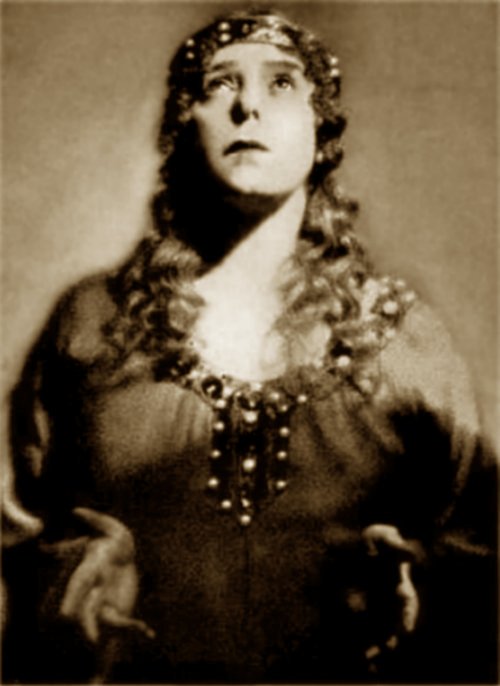 Married to Max von Schillings. Début Senta in Bayreuth in 1914, Elsa at the Met in 1923. Married to Max von Schillings. Début Senta in Bayreuth in 1914, Elsa at the Met in 1923.
Isolde, Elisabeth, Kundry in Bayreuth from 1924 to 1927.
Isolde: Recording unavailable.
KNIE Roberta - American
 Pupil of Dame Eva Turner. Bayreuth 1976-1977: Brünnhilde. Isolde at the Théâtre des Arts in Rouen (cond. Paul Ethuin). Pupil of Dame Eva Turner. Bayreuth 1976-1977: Brünnhilde. Isolde at the Théâtre des Arts in Rouen (cond. Paul Ethuin).
Isolde: Live recording, Geneva 1979.
Choppy phrasing, too much sound. High tones drawn, magnified. Wants to produce resonances: crushes, sings in an athletic manner, but collapses on the central difficulty which she vainly tries to avoid, thus removing any meaning from the work which ends on a 'Lust' sounding like a cavalry trumpet.
KNIPLOVA Nadezda - Czechoslovakian
 Début: Tosca, Aïda, Senta, Ortrud, Brünnhilde, Isolde. Début: Tosca, Aïda, Senta, Ortrud, Brünnhilde, Isolde.
Isolde: 1970, B. Gregor Supraphon, 11207 85.
Voice dark and heavy, excessive 'yawning', but singing disjointed, giving up the breath at the ends of phrases. Enlarges in the lower registers, draws out towards the top, thickens the vowels. Power, sound, pronounced vibrato.
KONETZNI Anny - Austrian 1902-1968
 Sister of Hilde Konetzni. First a chorister, lost her voice as a contralto, recovered it as a full soprano. Much appreciated by the Viennese. Tristan in Salzburg, cond. Toscanini. Sister of Hilde Konetzni. First a chorister, lost her voice as a contralto, recovered it as a full soprano. Much appreciated by the Viennese. Tristan in Salzburg, cond. Toscanini.
Isolde: Performance at Vienna Opera (2-1-1943), cond. Wilhelm Furtwängler.
Handles Isolde after the rest of the Wagnerian repertoire. Does not dominate her instrument in spite of Furtwängler's support. Emission far too moaning, grandiloquent portamenti, vibrato which does not allow clear entries or the rise to the low B natural of 'Atems'. Instead of drama, one is given melodrama.
KOVACS Eszter - Hungarian
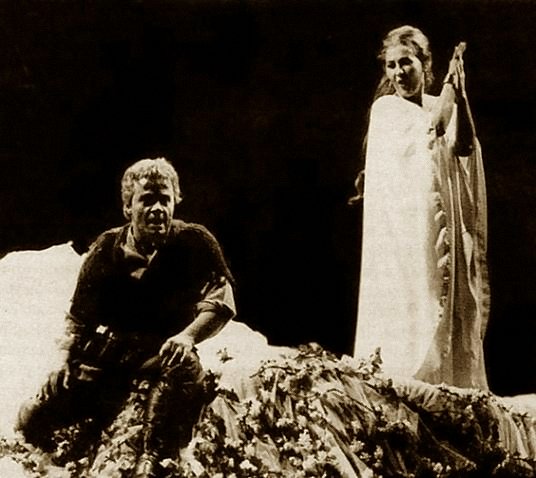 Studied in Budapest. Début: Prague, Warsaw, Bucharest, Berlin, Moscow, Düsseldorf. Studied in Budapest. Début: Prague, Warsaw, Bucharest, Berlin, Moscow, Düsseldorf.
Isolde: (13-7-1983) Dubrovnik Festival, Zagreb Philharmonic Orchestra, cond. Lovro von Matacic.
In the absence of a guiding line, the voice trembles and lacks poise all along the 'Liebestod'.
The singer does not sustain the medium which is placed too low; crushed gruppetti; recourse to methods facilitating the execution (notes scooped, G sharps attacked directly); a tone emission which modifies the style and engenders sadness mixed with embarrassment.
KUNZ Miriam
Isolde: Orchestra of the Tonhalle Zurich, cond. Boris Merrson.
Served by a consistent orchestra, Miriam Kunz, a piping voice, dashes into the 'Liebestod'. The tone colours on the thinned out and pointed 'i's'. She adapts the tempi to her liking, chops up the text, puts the orchestra at her service, pushes the resonances to the limits of suffocation... There are cases when - in the words of Richard Wagner - 'it is better to throw away the conductor's baton, rather than allow a work like Tristan to be butchered'.
KURT Melanie - Viennese 1880-1940
 Concert pianist (1897-1900). Début 1902 as Elisabeth. Studied in Berlin with Lilli Lehmann. Concert pianist (1897-1900). Début 1902 as Elisabeth. Studied in Berlin with Lilli Lehmann.
1914: Début as Isolde at the Met where she sang the Wagner repertory from 1914 to 1917.
Isolde: Anonymous Berlin Orchestra, 1911.
Curiously slow start for the beginnings of sound-recording which will oblige her to hurry 'in dem wogenden Schwall', a reference point in this analysis. The first part is marked by an accurate timbre and a projected diction in spite of the portamenti from high to low pitch and a noticeable vibrato. Quite lively, but painstaking, low middle range difficult and bogged down tones at the end of phrases as a consequence. 'Lust' too short. General impression of constant refusals of obstacles attempted at each renewed foray.
LARSEN-TODSEN Nanny - Swedish 1884-1982
 Studied in Stockholm, then in Berlin. Debuts at Stockholm Opera as Agathe. First soprano from 1907 to 1923. Scala Milan 1923. 1925-1927: Met. 1927-30: Covent Garden. 1927-31: Bayreuth (Brünnhilde, Kundry, Isolde). Then devotes herself to teaching. Studied in Stockholm, then in Berlin. Debuts at Stockholm Opera as Agathe. First soprano from 1907 to 1923. Scala Milan 1923. 1925-1927: Met. 1927-30: Covent Garden. 1927-31: Bayreuth (Brünnhilde, Kundry, Isolde). Then devotes herself to teaching.
Isolde: Columbia 1928, Festival Orchestra, Bayreuth, cond. Karl Elmendorff.
Listens too much to herself from the beginning. A certain distant dignity, lyrical outbursts at times affected, long bombastic phrases. Contemplative singing, almost static. This somewhat narrow voice seeking the beautiful sound, strangely restrains the impetus of a knowingly controlled passion. Not really the character of Isolde, even if she was chosen for this part by il Signore Toscanini rocking with laughter at the end of a Tristan performance, thus illustrating, once and for all, Wagner's painful statement: 'mediocre performances alone can save me; really good ones would drive people crazy'. (Letters to Mathilde Wesendonck).
LAWRENCE Marjorie - Australian, then American 1909-1979
 Studied in Paris with Gilly. Début 1932, Monte Carlo: Elisabeth. Paris Opéra, 1933: Ortrud. Studied in Paris with Gilly. Début 1932, Monte Carlo: Elisabeth. Paris Opéra, 1933: Ortrud.
Then Salome, Rachel, Aïda, Donna Anna, Valentine (Les Huguenots), Brünnhilde (Wagner) and Brunehilde (Reyer). Debuts at the Met in 1935: Die Walküre. Struck down by polio in 1941, sings, however, Venus at the Met (1943-1944) and Amneris (Paris Opéra, 1946).
Isolde: Recording not available.
LEHMANN Lilli - German 1848-1929
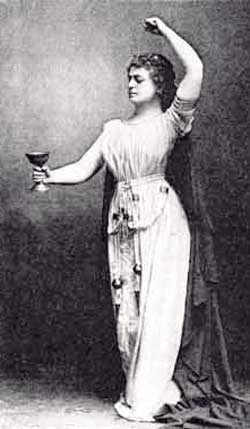 Sang in the first Ring 1876. New York debut (1885): Carmen. Was also the first Isolde and Brünnhilde at the Met (1886).`Had Geraldine Farrar and Olive Fremstad as pupils. Bayreuth, 1896: Brünnhilde. Outstanding Mozart interpreter in Salzburg. One proof copy of the'Liebestod' at Yale University, to be consulted there: Lilli Lehmann with orchestra conducted by Fritz Lindemann, made on July 5th, 1907 - Yale collection. Sang in the first Ring 1876. New York debut (1885): Carmen. Was also the first Isolde and Brünnhilde at the Met (1886).`Had Geraldine Farrar and Olive Fremstad as pupils. Bayreuth, 1896: Brünnhilde. Outstanding Mozart interpreter in Salzburg. One proof copy of the'Liebestod' at Yale University, to be consulted there: Lilli Lehmann with orchestra conducted by Fritz Lindemann, made on July 5th, 1907 - Yale collection.
Isolde: According to the correspondence of Hugo Wolf,Lilli is a singer unable to articulate: 'Isolde, a virago'. ('Oh Lilli, Lilli!... ' Richard Wagner).
LEHMANN Lotte - German, naturalised American 1888-1976
 Studied in Berlin, début in Hamburg (1910-1916). 562 performances, 52 parts. Privileged interpreter of Strauss (created Die Frau ohne Schatten in 1919). She leaves the stage in 1945. Recitals up to 1951. Author. Recordings from 1917 to 1946. Studied in Berlin, début in Hamburg (1910-1916). 562 performances, 52 parts. Privileged interpreter of Strauss (created Die Frau ohne Schatten in 1919). She leaves the stage in 1945. Recitals up to 1951. Author. Recordings from 1917 to 1946.
Isolde: Orchestra Staatskapelle Berlin, cond. Frieder Weissmann (18-06-1935).
Sings on the 'fibre' of the voice, projects a piercing tone with pronounced vibrato. Does not respect the dynamics, since she maintains in a very lively tempo a uniformly coloured timbre almost throughout. The second part is not a race to the depths (G sharp is short; inability to reach the B natural of 'Atems'; a bright 'Lust' stretched to her limits against the wishes of the composer...). This voice which has never been able to sing the 'Dove sono' of the Countess in The Marriage of Figaro, was much admired by Caruso who was perhaps impressed by the desperate canter of this Italian-style Valkyrie.
LEIDER Frida - German 1888-1975
 Dramatic soprano, début 1915: Tannhäuser. Sings her first Isolde in Hamburg (1919-1923), Dramatic soprano, début 1915: Tannhäuser. Sings her first Isolde in Hamburg (1919-1923),
then Berlin 1925-1938, Covent Garden (Isolde, Brünnhilde, 1924), and in 1933 (for two seasons only because of the arrival of Kirsten Flagstad): Isolde, Brünnhilde, Kundry. 1928-1939: Bayreuth. Then professor and producer in Berlin.
Isolde: H.M.V. 1931, cond. John Barbirolli.
Even, well-tempered voice, set on an unbridled tempo, avoiding any attempt at lucidity. Sails effortlessly through the orchestra; does not enter into the Wagnerian colour except when she rises from the G sharp to the middle B natural ('in des Welt-atems'). Her response to the rôle is minimal. Wagner 'off the rack' by virtue of an almost perfect instrument.
LIGENDZA Catarina - Swedish
 Her father, Einar Beyron, was Kirsten Flagstad's Tristan at the Scala in 1947. Studied at the Vienna Academy. 1965: La Contessa, Leonore. Bayreuth: Brünnhilde. Isolde (1974-1977). Her father, Einar Beyron, was Kirsten Flagstad's Tristan at the Scala in 1947. Studied at the Vienna Academy. 1965: La Contessa, Leonore. Bayreuth: Brünnhilde. Isolde (1974-1977).
Isolde: Bayreuth, July 1976, cond. Carlos Kleiber.
Sunken voice, loose, worn, almost spoken, with tremolo in the medium into which she bites in order to be able to hold on. Spreads in the second part ('in dem wogenden Schwall'), slows down; after this passage the voice is drowned in waves of orchestral sound. Carefully prepares the high tones, but sings turgidly, awkwardly and with hesitation. The G sharp and the B natural of 'Welt-Atems' are produced grandiloquent and... wrong. The tremolo of the F sharp of 'Lust' reminds one of the worn finales of second-rate operettas. The orchestra is present, and tries to carry away the singer who is exhausted.
LITVINNE Felia (Jeanne Vasil'yevna Schütz) - Russian of German-Canadian origin,
naturalised French 1860-1936
 Studied with Pauline Viardot and Victor Maurel. Début at the 'Italiens' in 1883. First Brünnhilde in French. First Isolde in Paris (1899). 1902: Cortot organises for her Tristan. First Kundry (Monte Carlo, 1913). Leaves the stage in 1917, the concert hall in 1924. Teacher of Germaine Lubin and Rose Féart. 40 recordings from 1902 to 1918. Studied with Pauline Viardot and Victor Maurel. Début at the 'Italiens' in 1883. First Brünnhilde in French. First Isolde in Paris (1899). 1902: Cortot organises for her Tristan. First Kundry (Monte Carlo, 1913). Leaves the stage in 1917, the concert hall in 1924. Teacher of Germaine Lubin and Rose Féart. 40 recordings from 1902 to 1918.
Isolde: In French, with piano accompaniment (Gramophone 1902).
Linear, dignified and proud; tone emission easy and clear; plenty of breath to encompass the longest phrases which are broken up without technical necessity. A certain amount of grandiloquence. A certain vocal tension. Is it this impression of power which impressed Alphonse Daudet and Germaine Lubin? But, is she really the 'dulce' Isolde? Her impresario Jos.-J. Schurmann who had toured Germany with her and who complained about not having made a penny, had to listen to the following: 'You announce a great singer from Paris Opéra. The audience is expecting to see a slim and elegant Parisian with a thin, weak but nevertheless agreeable voice. Instead, they are confronted with a singer of mag-nificent voice, in control of all the resources relevant to the art of singing; a very great artist, but a woman endowed with comfortable stoutness. Now, that annoys us. Nearly all our German singers are veritable mastodons. Only the blind can have an illusion about the feelings of love they seem to inspire into the tenor and the ferocious jealousy they awaken in the heart of the baritone. Positive as we are, we do ask for a little illusion in the theatre. It is that, and only that, we want from the bird from France.' (Mémoires, J.-J. Schurmann).
LJUNGBERG Göta - Swedish 1893-1955
 Début Elsa 1918. Sang Salome, Isolde, Kundry, Sieglinde. Important career in London. Début Elsa 1918. Sang Salome, Isolde, Kundry, Sieglinde. Important career in London.
Isolde: 1926 Grammophon orchestra, cond. Lawrance Collingwood.
Sings with a low-placed voice, a bit too melodramatic, a bit too much stressed, a bit too rushed.
Because of the proportions of this voice any flaws are all the more marked: staccato, tremolo, high tones escaping towards the back. Diction particularly emphasised (the consonants are clearly audible), perhaps as a result of the interpretation she wanted? To her credit, she sings the G sharp, B natural of 'Welt-Atems', but since she is running out of breath, we are deprived of a sustained 'Lust'. Is the part made for voices which are consistently short of breath?
LUBIN Germaine - French 1890-1979
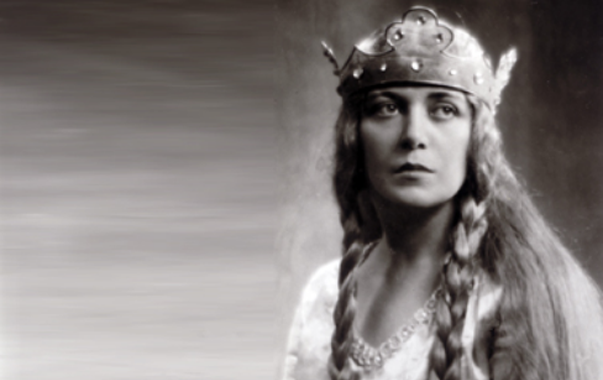 Début: Les Contes d'Hoffmann (1912). 1921: Sieglinde; 1923: Eva; 1930: Isolde in Paris and Covent Garden, then 1939: Isolde in Bayreuth. Début: Les Contes d'Hoffmann (1912). 1921: Sieglinde; 1923: Eva; 1930: Isolde in Paris and Covent Garden, then 1939: Isolde in Bayreuth.
Isolde: 1930-1931, cond. Henri Defosse.
Beautiful vocal line, with a clear distinctive timbre. expression nobly sustained in the legato, the voice slightly taken back before going towards the high notes. The gruppetti are pronounced with passion. The medium is copious, as befits a soprano considered dramatic, except the passage requiring total commitment ('in dem wogenden Schwall') in which the voice remains'short'. The final F sharp is very well rendered.
In 1939, Isolde was French.
LUDWIG Christa - German
 Sang Wagner (Brünnhilde, Isolde) on record only. On stage, Brangäne with Birgit Nilsson, also Fricka, Ortrud, Kundry, Waltraute and Venus (recordings with Solti). Sang Wagner (Brünnhilde, Isolde) on record only. On stage, Brangäne with Birgit Nilsson, also Fricka, Ortrud, Kundry, Waltraute and Venus (recordings with Solti).
Isolde: Royal Philharmonic Orchestra, cond. Otto Klemperer, 3-1-1962.
Listens to herself singing something resembling bel canto, placed somewhat low, and magnified in order to end up all the more easily in melodrama. On the verge of singing as in a musical, she brushes the G sharp of 'Welt', and does not reach the B natural of "Atems". The orchestra goes one way, she goes the other. The resonances are hollow for a mezzo, the vibrato wider than pleasant. Her comprehension of the legato is limited to drawing the notes into one another wihout respecting the real colour of the vowels. Finishes with an exaggerated triumphal vaudeville-like 'Lust'.
MARTIN Janis - American
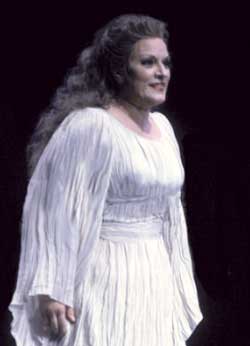 Bayreuth 1970: Eva, Sieglinde, Kundry. Bayreuth 1970: Eva, Sieglinde, Kundry.
Isolde: Geneva, Orchestre de la Suisse Romande, cond. Horst Stein, 7-2-1985.
Trembles, hurries slowly, bulges out from underneath her carapace revealing her extreme fragility: inappropriate change of colour, loss of timbre, maintains herself above the line, confuses volume and acceleration, then simpers with a voice from which one might have taken the skin of the harmonics (G sharp of 'Welt' short and not taken up again, F sharp of 'Lust' out of context) making her shiver on the spot.
MARTINELLI Germaine - French 1887-1950
 Mainly a singer in concerts, oratorios, sacred music, French melodies. Mainly a singer in concerts, oratorios, sacred music, French melodies.
Isolde: Pathé 1928, orchestra cond. François Rühlmann; in French.
A singer of Lieder. Clear and affected, limpid voice; monochordic tone placed high which seems thin when heard. Timbre appears in the second part of the recording. The rapid movement of the central episode is faithfully reproduced by the conductor, which puts the singer more at ease ('in dem wogenden Schwall'); however, the tempo is accelerated too much.
The G sharp of 'Welt' is somewhat short, the B natural of 'Atems'not reached. In the ensuing calm and serenity, the vibrato of the voice performing a conscientious 'Lust' lacking radiance and bloom, becomes noticeable.
 MARTON Eva - Hungarian MARTON Eva - Hungarian
Débuts 1968 at Budapest (The Golden Cock), dramatic soprano. Brünnhilde (Ring, San Francisco, 1984),
Elisabeth (Met, 25-11- 1982), Ortrud (Met, 1984).
Isolde : orchestra cond. András Kórodi (1978).
Stentorian voice, aged and rather formal, which is struggling along and lacks courage (all G-sharp are let out with glottal stop) before resolutely engaging in the Merry Widow style; does not master breathing nor legato. Cheeps the high notes, grinds, cannot undertake the passage “in dem wogenden Schwall…”. A “Lust” too short and too loud. The negation of the personage of Isolde.
 MATERNA Amalia - Austrian - 1844-1918 MATERNA Amalia - Austrian - 1844-1918
Débuts 1864 Graz (light röles) then Vienna Opera (L’Africaine, 1869) where she stayed until 1897.
Sang Offenbach when Wagner discovered her in 1876. Went to New York in 1880 for the new fashionable musical performances : song recitals with orchestra.
Isolde : Concert Lamoureux, 10-03- 1889, 17-03- 1892, 06-11- 1894. Documents not available.
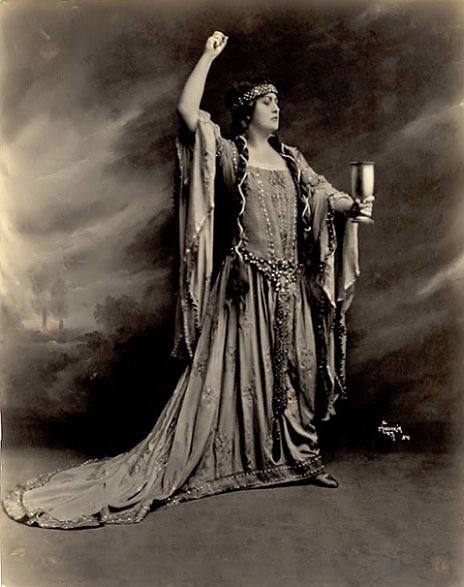 MATZENAUER Margarete - Hungarian - 181-1963 MATZENAUER Margarete - Hungarian - 181-1963
Alto then soprano. Studies in Berlin. Débuts in Berlin. 1901 to Strasbourg : Puck (Oberon) then Munich (1904-1911). Débuts New York Met in 1911 : Amneris, then Brünnhilde and Leonora (Il Trovatore). Stays at the Met until 1930. Sang Tristan with Urlus at the Théâtre des Champs-Elysées in the presence of Germaine Lubin. Has left fragments of arias for alto and the duet Brünnhilde and Sieglinde where she sings both rôles at the same time.
Isolde : has not left recordings of Isolde.
 MEIER Johanna - American MEIER Johanna - American
Studies Miami. Faust (Siebel) 1959-1960. 1974 Met : Donna Anna, La Contessa, Tosca, Ariane, Mathilde, Amelia, Agathe. Isolde, October 1979, Canadian Opera Co. Bayreuth 1981, 1982, 1983.
Isolde : Bayreuth, July 1981, cond. Daniel Barenboïm..
Does not master her fear. After a misplaced beginning, the orchestra rushes ahead and the singer with it, in order to better run aground. Then she tries to declaim : the orchestra overflows. She then pulls on the tones, enlarges and crushes, exhausting herself as the tempo is pressing under a command which would worry captain Daland in person. Has, however, the courage to sing the G-sharp of “Welt” before leading up quite well to “Lust”.
MELBA Nelly (Helen Porter Mitchell) - Australian 1859-1931
 Début: 1887 in Brussels (Gilda); 1888: Lucia, Covent Garden. 1889: Paris. Met, 4-12-1893 (Lucia). 1896: Brünnhilde in Siegfried, unfortunate attempt, as for Elsa. According to American critics (and the Frenchman Jacques Bourgeois) the most famous soprano of all times. Last performance at Covent Garden: 8-6-1926. Début: 1887 in Brussels (Gilda); 1888: Lucia, Covent Garden. 1889: Paris. Met, 4-12-1893 (Lucia). 1896: Brünnhilde in Siegfried, unfortunate attempt, as for Elsa. According to American critics (and the Frenchman Jacques Bourgeois) the most famous soprano of all times. Last performance at Covent Garden: 8-6-1926.
Isolde: Was never able to sing Isolde.
MÖDL Martha - German
 Dramatic soprano. Accountant. Studied singing at the age of 28: Nuremberg Conservatory, then Milan. 1945-1949 Düsseldorf Opera: Kundry. Gutrune in Hamburg. Bayreuth 1951- 1967: Brünnhilde, Isolde (in turn with Astrid Varnay). Dramatic soprano. Accountant. Studied singing at the age of 28: Nuremberg Conservatory, then Milan. 1945-1949 Düsseldorf Opera: Kundry. Gutrune in Hamburg. Bayreuth 1951- 1967: Brünnhilde, Isolde (in turn with Astrid Varnay).
Isolde: Municipal Orchestra of Berlin, cond. Artur Rother 1952.
Conducts the vocal line with emotion, if one does not consider the glottal stops, nor the chesty low tones, nor the darkened medium, nor the discoloured high tones. This line weighted down by excessive stressing does not manage to free itself from its thick veils and pomp. The vibrato is even emphasised by the passion which makes her sing an excessive 'Lust'. Even though the G sharp of 'Welt' is intense, the voice cannot reach the B natural (Atems). Sings in a zigzag and yet makes the handkerchieves come out in Bayreuth: one thing does not prevent the other.
MONSEGUR-VAILLANT Giselle - French

Concert pianist. Debuts Radio France (Rosine, Juliette, Constance, Lucia, Elena...). Created the part of Mirèio (the opera by Gounod) in Provençal and the Songs of the County of Foix (Radio Helsinki 1981; Radio Mediane International, 1983). Rumanian State Opera (1982): Marguerite (Faust by Gounod); Magyar State Opera (1982): Violetta (La Traviata, by Verdi). 1984:
Exceptional Wagner Concert, Castle of Montségur (County of Foix, piano Steinway). Operatic arias (Juliette, Marguerite, Violetta, La Contessa, Norma, Isolde) MV 1207. Concert Fauré (Conservatoire National Supérieur de Musique de Paris, 14, rue de Madrid, Salle Gabriel Fauré, 1991) piano Steinway. Concert Schumann (Robert-Schumann-Haus, Zwickau, 1992) piano August Förster 1943 (world première). Concerts Schubert, Schumann, Fauré, Wagner: Moscow Conservatoire (Maly Hall, Rachmaninoff Hall, piano Steinway) and Riga (Vagnera zale, piano Bechstein), 1993.
Isolde: Maly Hall, Moscow Conservatoire, 30-04-1993, the singer accompanying herself at the piano (piano Steinway) - world première.
From the wavering tremolo of the piano, fragments of burning themes are sent forth, the sustained notes calling the voice towards the depths. From 'mild und leise' and throughout, high and low harmonics press in the heart of an inexorable timbre which pours forth in a fabulous legato-gesang the glacial sorrow of the heroine and the Bellinian souvenir of her all-consuming love into a crescendo of 'surge-desire' where Wagner torments the line as if he wanted to extract the soul from its tunic of flesh. Of this fight always renewed between the harmonic writing and the legato, where the cantabile preserves all its rights, one has to remember - following the desperate 'klinget' and the paroxysm of 'in dem wogenden Schwall', - the extraordinary rise to the B natural of 'Atems' which sets the voice free, enabling it to enter, piano, the immaterial sphere of another world surrounded by a nimbus of light, thus restoring to Isolt the contours of her 'dulce' everlastingness.
One can only imagine the impact of this interpretation accompanied by the Berlin Philharmonic Orchestra conducted by Siegfried Wagner, on the 11th October 1926.
Monsegur Vaillant Website : https://www.monsegur-vaillant.com
NAPIER Marita
 Début 1969: Venus in Bielefeld. Bayreuth: 1974, Sieglinde and 1975, Eva. Début 1969: Venus in Bielefeld. Bayreuth: 1974, Sieglinde and 1975, Eva.
Isolde: (Tristan und Isolde, Pact Opera) Pretoria, 11-3-1985.
In the presence of Wolfgang Wagner, guest of honour of the Pact and the South African Richard Wagner Society. Recording not available.
NILSSON Birgit - Swedish
 Lyrical soprano. Elsa in Bayreuth 1954. Isolde, Bayreuth 1957 until 1970. 1957: Isolde in Covent Garden. 1959: Isolde at the Met. Other Wagnerian parts: Sieglinde, Venus, Senta and Brünnhilde (Götterdämmerung). Lyrical soprano. Elsa in Bayreuth 1954. Isolde, Bayreuth 1957 until 1970. 1957: Isolde in Covent Garden. 1959: Isolde at the Met. Other Wagnerian parts: Sieglinde, Venus, Senta and Brünnhilde (Götterdämmerung).
Isolde: Vienna Philharmonic Orchestra, cond. Hans Knappertsbusch, 1959.
Distinctive timbre, even luminosity, but the singer consistently shapes the phrases on the same model without changing colour to suit the contents, regardless of the text. Passes from piano to forte in an altogether exterior immateriality. Crescendi and perspectives are rendered at the cost of the absolute Wagnerian legato. High tones are drawn, out of breath, taken with a spoon from underneath towards the outside of the plate. Suddenly interrupts the G sharp; B natural of'Atems' hardly audible; a well-sung 'Lust'.
Coasted in this part 208 times without ever daring the crossing. Will have her place in dry-dock at the side of the Wasa.
NORDICA Lillian - American 1857-1914
 First Elsa in Bayreuth (1894). Originally coloratura: Lucia, Ophelia, Philine, Marguerite, Gilda, Violetta. Having squandered her fortune, she leaves for Australia and perishes following a shipwreck near Java. Wagnerian parts: Isolde, Brünnhilde. First Elsa in Bayreuth (1894). Originally coloratura: Lucia, Ophelia, Philine, Marguerite, Gilda, Violetta. Having squandered her fortune, she leaves for Australia and perishes following a shipwreck near Java. Wagnerian parts: Isolde, Brünnhilde.
Isolde: Columbia orchestra, New York 1911.
From the very first strains of 'mild und leise', this coloratura enters the Wagnerian groove at the sound-speed of her time (78's, four minutes in length). Sings flat and straight, short of breath in the middle register ('mich klinget'), does not control the G sharps, 'Lust' too sustained and too short. Cannot be judged.
NORMAN Jessye - American
 Voice teacher who supposedly wishes to sing Isolde on stage. 1968: Elisabeth. 1969: Elsa. Voice teacher who supposedly wishes to sing Isolde on stage. 1968: Elisabeth. 1969: Elsa.
Isolde: French TV, Grand Echiquier, cond. Jean-Claude Casadesus, 19-11-1984.
Beginning out of tune and discoloured (end of 'leuchtet' inaudible); a voice which tends to fade in and out whole planes of sound. Mixed chest tones, skids towards the high notes. Opens her mouth excessively, uncovering her glottis: yodels with two registers separated by an abyss. Presses the rôle to her breast, bruising it severely in the process. The 'in dem wogenden Schall' is barked ('Bayreuth bark' deplored by Wagner himself who requested his interpreters to singà l'Italiana; yet the composer - in contrast to the 'Chiens Mélomanes' of Méhul - never singularised the keys for the hunting pack of King Marke!). The singer chokes like somebody infuriated. She makes a very last bid to reach the G sharp of 'Welt', which falls down onto the middle B natural, then again loses her timbre with a 'höchste Lust' preceded by simpering.
In this telegenic aquarium, Archimedes' Principle would have to be readjusted.
OHMS Elisabeth - Dutch 1888-1974
 Violonist and pianist. Sang in Bayreuth, Munich, Berlin. Début 1921. 1927-1928: Kundry, cond. Toscanini. 1931: Bayreuth, Kundry. At the Met, principal Wagner parts except Senta. Violonist and pianist. Sang in Bayreuth, Munich, Berlin. Début 1921. 1927-1928: Kundry, cond. Toscanini. 1931: Bayreuth, Kundry. At the Met, principal Wagner parts except Senta.
Isolde: Berlin Opera Orchestra, 1929, cond. Julius Prüwer.
A voice like an instrument according to Wagner's wishes or a violonist trying to respect a scrupulous legato? The orchestra, an indistinct mass without mystery, adapts itself to this rich, dramatic tone which is flat at times and shows deficiencies: pianissimi, ends of phrases, clarity of emission. Also a slight vibrato accentuated in the high notes, which follows the portamenti from high to low, with a well-produced diminuendo, but very much opera in the bad sense of the word; 'Lust' not under control.
OLIVERO Magda - Italian
 Tullio Serafin recommends to her Lucia, Amina, Gilda, but she chooses Elsa, Violetta, Manon and Liù. 1952: Mimi (London), 1975: Tosca at the Met. Tullio Serafin recommends to her Lucia, Amina, Gilda, but she chooses Elsa, Violetta, Manon and Liù. 1952: Mimi (London), 1975: Tosca at the Met.
Isolde: In Italian, anonymous orchestra, 1958.
Clear and sharp soprano in the Italian manner 'aperto ma non coperto'. The voice draws towards the high tones and cannot come down again pianissimo ('sanft entweht'). Does not go to the ends of the phrases, drilling them nasally in the worst bel canto style. Slows down the movement of the wave ('in dem wogenden Schwall'), and accumulates shrill sounds by chopping her delivery. Shouts the G sharp of 'Welt' covered up by the orchestra; the B natural (Atems) is non-existent. The trembling semibreve (whole note) of the F sharp of 'Lust' is rendered pianissimo.
OSTEN Eva von der - German 1881-1936
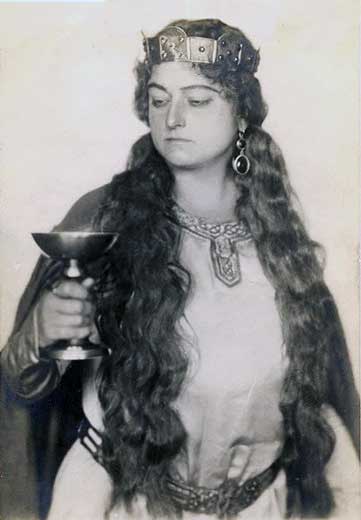 Début in Dresden where she was first soprano from 1902 to 1930. Created Octavian. 1913- 1914: Covent Garden (Octavian, Ariane, Isolde, Sieglinde and Kundry). Sang Tosca. Début in Dresden where she was first soprano from 1902 to 1930. Created Octavian. 1913- 1914: Covent Garden (Octavian, Ariane, Isolde, Sieglinde and Kundry). Sang Tosca.
Isolde: Recording not available.
PLAICHINGER Thila - German 1868-1939
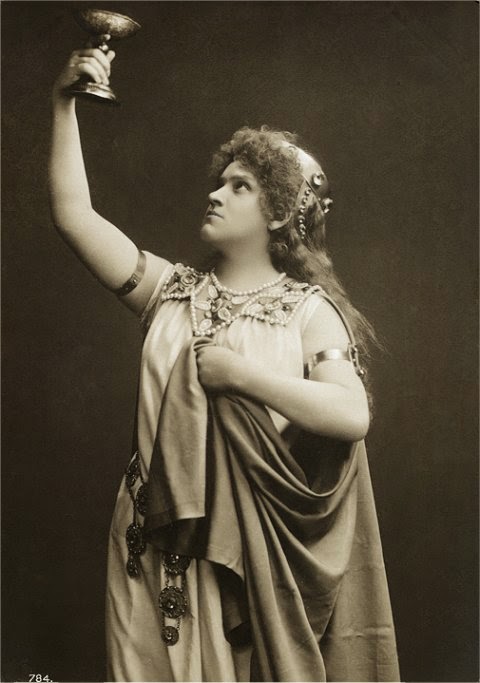 Dramatic soprano. Sings Wagner, Weber, Richard Strauss. Star of the Opera of Berlin. 1896- 1897 in Bayreuth. Isolde, 1899 in Frankfurt. Brünnhilde and Isolde,1901-1914 in Berlin. 1904, Dramatic soprano. Sings Wagner, Weber, Richard Strauss. Star of the Opera of Berlin. 1896- 1897 in Bayreuth. Isolde, 1899 in Frankfurt. Brünnhilde and Isolde,1901-1914 in Berlin. 1904,
Isolde (also Venus and Ortrud) Covent Garden. Created Elektra (Berlin, 1910).
Isolde: Recording not available; the record exists.
PONSELLE Rosa (Ponzillo Rosa) - American; daughter of Neapolitan parents 1897-1981
 Sang in cinemas and church choirs. Vocal studies in New York. Caruso hears her and recommends her to Gatti-Casazza. Début at the Met: 15th november 1918 in La Forza del Destino (Force of Destiny). Withdrew in 1937. Sang Norma (Covent Garden, 1929) and at the Met, La Traviata (1930). Sang in cinemas and church choirs. Vocal studies in New York. Caruso hears her and recommends her to Gatti-Casazza. Début at the Met: 15th november 1918 in La Forza del Destino (Force of Destiny). Withdrew in 1937. Sang Norma (Covent Garden, 1929) and at the Met, La Traviata (1930).
Isolde: Recording catalogue n° EJS243 National Sound Archive, London.
Concert recital with thin piano accompaniment, of a relatively light genre, insufficient sustaining and legato. Deficient in low harmonics stressed by affectation and by the portamenti of a tone permanently focused in the head: 'klagend' in staccato, no crescendi or perspectives, elimination of the passage 'in dem wogenden Schwall' by means of a ridiculous acceleration, nasal twang ('klinget, schwinget'). Rises to the B natural of 'Atems' in two stages in order to produce more easily a clearly ululated 'Lust'. An end-of-career 'Liebestod': was unable to resist the most dangerous of temptations.
PRICE Leontyne - American
 Studied at Juilliard School, New York 1949-1952. Début Porgy and Bess, 1952. Tosca, 1955. Studied at Juilliard School, New York 1949-1952. Début Porgy and Bess, 1952. Tosca, 1955.
Aïda, 1960.
Isolde: RCA recording 1980, stereo. Philharmonic Orchestra, cond. Henry Lewis.
Shapes the phrases in an arbitrary way. Does not respect the German text. Unevenness of the voice, uncontrolled vibrato, discoloured tones. First gruppetto slow, crushed, thick. Last phrase sung without distinctive timbre, in the head. Vocally unable to sing an un-American 'Liebestod'.
PRICE Margaret - Welsh
 1962: Cherubino (ENO). Covent Garden 1963: Cherubino. 1971: Constanze (Glyndebourne), then the Countess (Le Nozze di Figaro), Fiordiligi, Pamina, Donna Anna (Covent Garden) and Constanze (Salzburg 1975). Verdi: Desdemona, Paris Opéra 1976. 1962: Cherubino (ENO). Covent Garden 1963: Cherubino. 1971: Constanze (Glyndebourne), then the Countess (Le Nozze di Figaro), Fiordiligi, Pamina, Donna Anna (Covent Garden) and Constanze (Salzburg 1975). Verdi: Desdemona, Paris Opéra 1976.
Isolde: D.G.G. recording, cond. Carlos Kleiber, Radio Leipzig Orchestra.
Suave voice, covered, which escapes in spirals and lightens the high tones without the resources of the timbre. The orchestra follows, endeavouring to imitate, by avoiding covering the lyrical outbursts which become dull and sink into somnolence on both sides. No middle range, no stamina for the part on stage. Non-existent character.
RAKOWSKA Elena
 Married to Tullio Serafin. Sang Wagner and Strauss. Married to Tullio Serafin. Sang Wagner and Strauss.
Isolde: At the Champs-Elysées Theatre with an Italian company, 1922. Recording not available.
RICIARELLI Katia - Italian
 Isolde: Concert 'Vorspiel und Liebestod' at the Fenice in Venice 13-2-1983 (Wagner Year). Isolde: Concert 'Vorspiel und Liebestod' at the Fenice in Venice 13-2-1983 (Wagner Year).
Recording not available.
RUSS Giannina - Italian 1873-1951
 Studied piano and singing. Début 1903. 1904: Paris. 1905: Monte Carlo. Dramatic soprano. Studied piano and singing. Début 1903. 1904: Paris. 1905: Monte Carlo. Dramatic soprano.
Recorded extracts from Norma, Traviata, Aïda. Invited to the Scala, Rome, London, St Petersburg, Vienna, Lisbon. 1908: Met. Sang with Patti, Tamagno, Caruso. Finished her days at the Casa Verdi.
Isolde: On record (Gramophone and Typewriter).
Throaty delivery, typical of her time, without mellowness, without resonances in the high register. The emission is projected and sustained, but always in the same colour. Phrases cut from time to time. Has problems singing piano (G sharp, low G). Produces a straightforward, uncomplicated sound, accompanied by a 'squeaking' orchestra.
RYSANEK Leonie - Austrian
 Dramatic soprano. Début: Agathe (1949) Innsbruck. Senta, Sieglinde (1950-1952 Saarbrücken), then Munich. Bayreuth Festival 1951: Sieglinde. Then State Opera, Vienna. New York, Met: début in 1955. 1956, San Francisco: Senta, Sieglinde. Bayreuth 1958: Elsa. Dramatic soprano. Début: Agathe (1949) Innsbruck. Senta, Sieglinde (1950-1952 Saarbrücken), then Munich. Bayreuth Festival 1951: Sieglinde. Then State Opera, Vienna. New York, Met: début in 1955. 1956, San Francisco: Senta, Sieglinde. Bayreuth 1958: Elsa.
Isolde: Had accepted to sing Isolde, but was dissuaded from doing so by Karl Böhm.
SASS Sylvia - Hungarian
 Sang Gutrune in Budapest in 1972. Sang Gutrune in Budapest in 1972.
Isolde: Cond. András Kórody, Hungaroton (1978).
Voice covered, timbre not pure. Thins the tone and 'yawns' excessively. Transforms emission of the high fifth on the vowel 'a' which pulls the voice backwards while leaning on the larynx.
Slides into notes, and camouflages this as a precious effect of head voice ('sanft entweht', 'um mich klinget') before suddenly interrupting for lack of breath. Barely touches the line at 'in dem wogenden Schwall' in order to hold out better. In evident difficulty in the entire final part rendered piano up to a wobbling 'Lust'.
The bagman of the Juilliard School and the Chef of the Halle aux Grains (Toulouse) believed to have heard in her the Violetta of the century (in the fourth act?).
SCHIRMER Astrid
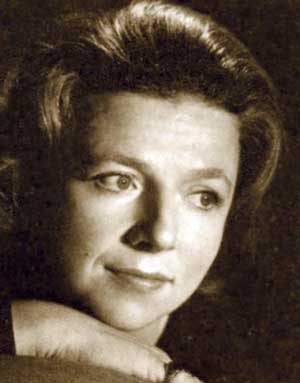 Isolde: Nice Opera 1979. Isolde: Nice Opera 1979.
Constantly behind the conductor; slides into notes, sings in the throat: G sharps forced, low tones disappear altogether. Almost succeeds in producing an acceptable 'Lust', for it is sung on its own and out of context. Difficult to find the frequency on which she emits.
SCHLÜTER Erna - German 1904-1969
 1922: Début as contralto. Understudy for Kirsten Flagstad as Leonore. 1946-1957: Brünnhilde at the Met. 1922: Début as contralto. Understudy for Kirsten Flagstad as Leonore. 1946-1957: Brünnhilde at the Met.
Isolde: Orchestra of the Berlin State Opera, cond. W. Furtwängler (3-10-1947).
Trumpeting voice in the Italian manner, 'grain' exposed and almost constantly escaping towards the top. Sings in long crushed phrases with very Germanic conviction, desperate and exteriorised. The high tones skid, the low ones fall. She lags behind the orchestra which cannot support this interpretation so far from Wagner's drama, and which manifests itself only in the finale where the singer finds her way back to the conductor and fires a well-produced 'Lust' rendered pianissimo.
SCHNORR von CAROLSFELD Malvina (Malvina Garrigues) - German 1825-1904
 Isolde: Created the part (première in Munich 10th June 1865, cond. Hans von Bülow). Isolde: Created the part (première in Munich 10th June 1865, cond. Hans von Bülow).
Thrown into the water by King Louis II of Bavaria during a scene worthy of a Rhinedaughter.
SCHRÖDER-FEINEN Ursula - German
Début Gelsenkirchen. Then Berlin, Hamburg, Met. 1971, Bayreuth: Elsa, Brünnhilde (Siegfried) until 1975 (Brünnhilde, Kundry). An Isolde in Montreal.
Isolde: Recording at Gelsenkirchen (20-04-1976), cond. Ljubomir Romanski.
Does not enter into the top register, sings cautiously, throat wide open, worn voice. Rises without 'li tons' and narrows as the 'Liebestod' progresses. Tries to sustain a tessitura in which she is not comfortable. Shaken by a rapid, lively movement which obliges her to dance on a tight-rope, she, eventually, has a great fall when hitting the G sharp. A discoloured Isolde.
SEDLMAIR Sophie - German 1857-1939
 Début in operettas in Leipzig.Leonore in Fidelio (1893). Becomes a dramatic soprano after having met Materna. Invited to St Petersburg, Budapest and Covent Garden, singing Wagnerian repertoire. Début in the love-duet of Tristan with Leo Slezak. Début in operettas in Leipzig.Leonore in Fidelio (1893). Becomes a dramatic soprano after having met Materna. Invited to St Petersburg, Budapest and Covent Garden, singing Wagnerian repertoire. Début in the love-duet of Tristan with Leo Slezak.
Isolde: Recordings not available (1903-1904 in Vienna).
SEINEMEYER Meta - 1895-1929
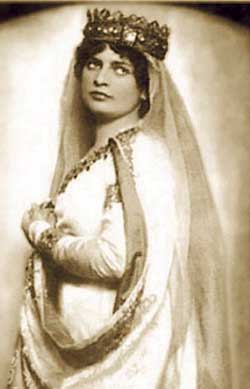 In Berlin 1920, Elsa, Elisabeth, Agathe, La Contessa. 1929 Sieglinde, Eva, Elsa at Covent Garden. In Berlin 1920, Elsa, Elisabeth, Agathe, La Contessa. 1929 Sieglinde, Eva, Elsa at Covent Garden.
Isolde: Berlin Philharmonic Orchestra, cond. Max von Schillings 1927.
Correctly placed vocally at the beginning; sounds like a Viennese waltz but not as well-oiled as Vienna would prefer; slightly short of breath, but full of emotion. Voice with non-courtly resonances nearer Beroul's tone than Thomas's; swelling crescendi respected, interesting orchestra. A taste of raw milk which is absent from the pasteurised recordings of our time.
SILJA Anja - German
 Soprano. 1956: Rosina (at the age of 16) Braunschweig. Zerbinetta, Queen of the Night at the age of 19 (Aix-en-Provence). 1960: Senta in Bayreuth, then Elisabeth, Eva, Freia until 1967. Soprano. 1956: Rosina (at the age of 16) Braunschweig. Zerbinetta, Queen of the Night at the age of 19 (Aix-en-Provence). 1960: Senta in Bayreuth, then Elisabeth, Eva, Freia until 1967.
Isolde, Brünnhilde, in Frankfurt. Belongs to Stuttgart Opera. Salome (producer Wieland Wagner), Lulu, Marie in Wozzeck. Sang in concert ('Isoldes Liebestod') with Tony Poncet (Kulturring Wolfsburg, 11-1-1964, Stadthalle, Nordwestdeutsche Philharmonie, cond. Heinz Meyer-Kundt).
Isolde: Radio recording 1971, cond. Jussi Jalas.
This 'lyrical' coloratura soprano thickens the middle range from the beginning, then thins the tones, 'leans' on the diction, lets her vibrato stream, indulges in fading. In search of modernism the actress hangs on to a painful 'verismo' which sinks into sadness and more than approximate purity; a vocalism, at times, bordering on histrionics.
SOYER Marguerite - French
 At first violoncellist, prize winner at the Paris Conservatoire; voice sounding only partly soprano, sang dramatic parts at the Opéra Comique and Brangäne at Paris Opéra. She took the part of Isolde at the Opéra Comique in turn with Suzanne Balguerie. At first violoncellist, prize winner at the Paris Conservatoire; voice sounding only partly soprano, sang dramatic parts at the Opéra Comique and Brangäne at Paris Opéra. She took the part of Isolde at the Opéra Comique in turn with Suzanne Balguerie.
Isolde: Gramophone 1930-1931, cond. Piero Coppola; in French.
The quick vibrato of this big-sounding voice adapts itself to the rigour and liveliness of the central climaxes, although the singer 'tosses off' the G sharps; has deficiencies in the last pianissimo phrase and the final 'Lust'. Does not know how to realise the idea of 'endless melody'.
STUDER Cheryl - American
 Sings in church choirs at the age of 5 or 6. Prizewinner at the Met Auditions (1978). Sings in church choirs at the age of 5 or 6. Prizewinner at the Met Auditions (1978).
Hochschule für Musik (Vienna). Member of the Bayerische Staatsoper. 1985, Wolfgang Wagner asks her to study the rôle of Elisabeth (Tannhäuser) for the opening of the Bayreuth Season, although, according to her, too many Wagnerian parts are too 'low' for her and also'incredibly low' are the fees paid in Bayreuth.
American début: Micaëla (Lyric Opera of Chicago), Same rôle at the Met, four years later. Elsa and Elisabeth in Bayreuth. Elena (Verdi); Donna Anna, La Contessa (Mozart). Wishes to sing La Sonnambula (Bellini).
Isolde: Symphony Orchestra of the Bayerische Rundfunk, cond. Jeffrey Tate, 1989.
Sings without veritable timbre. Barely touches the text or collapses onto it. Whining emission of a small voice (does she not say herself that Micaëla is too 'low' a rôle for her?) which loses its hold towards the high register in a sophisticated bel canto style. The F sharp of 'klinget' is out of tune. The G sharp of the light soprano causes her a problem. The Fs are acid, the lyrical thrusts controlled. Lacking in breath support she cannot sing in the low register. Surfs on the crest of the voice before being rolled up in the stuff produced by an orchestra which is knitting
Wagnerian material in her place. An airy 'Lust' with tremolo. Has not seen a voice teacher nor a language teacher these last ten years. Having stood the test at Bayreuth, says she, now wishes to gain recognition at the Teatro alla Scala, Milano.
SUTHERLAND Joan - Australian
 Studied the piano and singing. Gilda 1951, Lucia 1959 at Covent Garden. Recorded 'Elisabeth's Greeting' from Tannhäuser. Studied the piano and singing. Gilda 1951, Lucia 1959 at Covent Garden. Recorded 'Elisabeth's Greeting' from Tannhäuser.
Isolde: National Philharmonic Orchestra, London, cond. Richard Bonynge (Decca 1978-1979).
Overthickens her light voice, distended with uncontrolled vibrato. Suffocates progressively and loses control over her imprecise muffled high tones. Floating resonances sustained by constant orchestral intervention, which are only distantly related to the score ('in dem wogenden Schwall...' completely covered and fallen in the medium)... This stereophonic recording cannot be listened to.
TEBALDI Renata - Italian
 Studied the piano. Eva at the Scala in 1946-1947 for the re-opening of Milan Opera. Studied the piano. Eva at the Scala in 1946-1947 for the re-opening of Milan Opera.
Isolde: On record, 1969, A. Guadagno, Decca set 39-40 2d.
TERNINA Milka - Yugoslavian 1863-1941
.jpg) Début 1882 (Un Ballo in Maschera). Created Tosca in London where she sang from 1898 to 1906. 1899: Bayreuth where she sang only once, because she created Kundry in the US in 1903. Début 1882 (Un Ballo in Maschera). Created Tosca in London where she sang from 1898 to 1906. 1899: Bayreuth where she sang only once, because she created Kundry in the US in 1903.
Isolde at the Met with Jean de Reské. Said to be a great Wagnerian.
Isolde: Inaudible cylinder recording.
TETRAZZINI Luisa - Italian 1871-1940
 1890: L'Africaine. 1894: Isolde at the Scala. 1907: Violetta. 1908 to 1912: Lucia, Gilda, Amina, Lakmé. 1890: L'Africaine. 1894: Isolde at the Scala. 1907: Violetta. 1908 to 1912: Lucia, Gilda, Amina, Lakmé.
Isolde: At the Scala at the age of about 23, in the presence of Queen Margherita of Italy who wished to hear Wagnerian music. At the Met, 1911-1912. Recording not available.
TRAUBEL Helen - American 1899-1972
 Born in the US of German parents. Belated career; replaced Flagstad at the Met in 1941; loved night-clubs, whisky; wrote detective novels. At the Met in 1939, Sieglinde, Brünnhilde, Born in the US of German parents. Belated career; replaced Flagstad at the Met in 1941; loved night-clubs, whisky; wrote detective novels. At the Met in 1939, Sieglinde, Brünnhilde,
Elisabeth, Elsa, Kundry, Isolde.
Isolde: Columbia 1943, cond. Artur Rodzinski.
The voice gets going abruptly and heavily like the orchestra. Her tone lacks body, medium and low registers thick and crushed. Precipitates into the passage 'in dem wogenden Schwall...'.
High tones 'scooped' and often shrill, 'Lust' rendered fortissimo or nearly. Minimal response to the text.
TURNER Eva - English 1898-1990
 1916 to 1924, Brünnhilde, Freia (1924) at Covent Garden; then Sieglinde and Isolde. Dame Eva Turner left her jewellery to Dame Gwyneth Jones, for life, and then to the Royal Opera House, Covent Garden. 1916 to 1924, Brünnhilde, Freia (1924) at Covent Garden; then Sieglinde and Isolde. Dame Eva Turner left her jewellery to Dame Gwyneth Jones, for life, and then to the Royal Opera House, Covent Garden.
Isolde: Recording not available.
VAELKKI Anita - Finnish
 Dramatic soprano. Début as an actress at the theatre and as a singer in operettas (1952-1953) at Vaasa. Studied with Lea Pitti in Helsinki. 1955: Helsinki Opera. 1960: Stockholm Opera and Prague Opera. >From 1960 to 1964: Covent Garden. 1962: Metropolitan Opera (Brünnhilde in Die Walküre). 1963: Philadelphia and State Opera Vienna. 1963-1964: Bayreuth (Brünnhilde in Die Walküre). 1965-1966: Met (Kundry, Parsifal). Dramatic soprano. Début as an actress at the theatre and as a singer in operettas (1952-1953) at Vaasa. Studied with Lea Pitti in Helsinki. 1955: Helsinki Opera. 1960: Stockholm Opera and Prague Opera. >From 1960 to 1964: Covent Garden. 1962: Metropolitan Opera (Brünnhilde in Die Walküre). 1963: Philadelphia and State Opera Vienna. 1963-1964: Bayreuth (Brünnhilde in Die Walküre). 1965-1966: Met (Kundry, Parsifal).
Isolde: Suomen Kansallisooppera, Orch. of the Finnish National Opera, cond. Ulf Söderblom.
Murmurs and loses colour from the outstart, ever on the verge of sinking; tears her voice in the high tones before breaking down at the end of the melodic curve ('klinget'). Discolours the vowels which are thickened. A tendency to chop up the line of the text permanently with unnecessary breathing; breaks in two between 'Welt' and 'Atems' which, like the final 'Lust', separated from the context and hurled discoloured, loses all meaning. Are we dealing with a rehearsal? Yet Anita Valkki is remembered by the public and the fair critics of Helsinki for her warm metallic timbre, with crystalline high tones and for her great stage presence as actress and singer. Orchestra and conductor of quality.
VARNAY Astrid - American
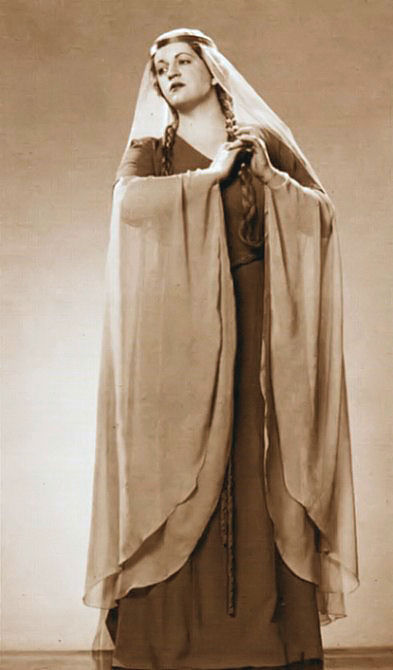 Born in Sweden from Hungarian parents. Dramatic soprano. Met: 1941 Sieglinde, Brünnhilde, Elsa, Elisabeth. Covent Garden, 1948: Brünnhilde (Siegfried). In 1951 called to Bayreuth for nearly 20 years (1951-1968). Born in Sweden from Hungarian parents. Dramatic soprano. Met: 1941 Sieglinde, Brünnhilde, Elsa, Elisabeth. Covent Garden, 1948: Brünnhilde (Siegfried). In 1951 called to Bayreuth for nearly 20 years (1951-1968).
Isolde: 16-6-1951. Columbia record. Philharmonia Orchestra, London, cond. George Sebastian.
Colour of voice nearer Ortrud, large and plaintive timbre; glided approach to resonance which, inside the phrase, stretches stiffly. Flat and affected diction. Listens to herself, slightly theatrical, monotonous style, glottal stops, high tones drawn to near-discolouring, final F sharp strangled. A sonorous Isolde.
VASQUEZ Italia - Italian 1869-1945
 Born in Trieste of Italian parents. Finished her life at Budapest in August 1945. Studies: piano, then singing at Geneva with the Italian Alfonso Dami. 1889: great success at Budapest under the name of 'singing Countess'; had married a Hungarian Country Squire in meantime. Created Nedda (I Pagliacci) in Hungary. Engaged by Gustav Mahler, the director of the Hungarian National Opera. Sang Aïda, Santuzza and the great Wagnerian rôles. In 1901, she sings in the first Hungarian production of Tristan at Budapest (28th November) in the Hungarian translation by E. Abranyi. Belonged to the Hungarian Opera until 1917. Then became a voice teacher. Born in Trieste of Italian parents. Finished her life at Budapest in August 1945. Studies: piano, then singing at Geneva with the Italian Alfonso Dami. 1889: great success at Budapest under the name of 'singing Countess'; had married a Hungarian Country Squire in meantime. Created Nedda (I Pagliacci) in Hungary. Engaged by Gustav Mahler, the director of the Hungarian National Opera. Sang Aïda, Santuzza and the great Wagnerian rôles. In 1901, she sings in the first Hungarian production of Tristan at Budapest (28th November) in the Hungarian translation by E. Abranyi. Belonged to the Hungarian Opera until 1917. Then became a voice teacher.
Isolde: G and T, Budapest 1902, by the Countess Italia Vasquez (accompanied by piano). Heightened recording which reduces a little a voice from the throat, placed high and short of harmonics. Different tempi with acceleration in the second part: is this due to respect for the exigencies of 78-80 record sides? At times the Countess screeches without articulating, cuts the phrases in unexpected places, does not differentiate between the levels or the perspectives. She holds, for quite a long time, the 'klinget' which, nevertheless, deteriorates towards the end. The central surge is sung too fast. The 'Welt-Atems' is held with quite an expressive timbre, as is the'Lust' which is not heartfelt.
Does the singer understand that this is not an arietta 1902 in the style of La Troupe Jolic ur with rubato accompaniment by an anonymous piano?
VIARDOT Pauline, Michelle, Ferdinande - French 1821-1910
 Studied singing with her parents and piano with Franz Liszt. Younger sister of Maria Garcia- Malibran (1808-1836). Début: Brussels, 1837. First to sing the part of Fidès (Le Prophète by Meyerbeer, Paris Opera, 1849) and Sapho by Gounod (1851). First stay in Russia, 1843. Sang Orfeo ed Euridice by Gluck arranged by Berlioz (Orphée et Eurydice), in 1859. Excelled in Semiramis, Norma, Lucia di Lamermoor, Don Pasquale, La Juive, Don Giovanni (Zerlina and Donna Anna; gave to France the manuscript of Don Giovanni by Wolfgang Amadeus Mozart), Iphigénie en Tauride (Iphigenia in Tauris), Alceste, La Favorite, Il Trovatore, Fidelio. Studied singing with her parents and piano with Franz Liszt. Younger sister of Maria Garcia- Malibran (1808-1836). Début: Brussels, 1837. First to sing the part of Fidès (Le Prophète by Meyerbeer, Paris Opera, 1849) and Sapho by Gounod (1851). First stay in Russia, 1843. Sang Orfeo ed Euridice by Gluck arranged by Berlioz (Orphée et Eurydice), in 1859. Excelled in Semiramis, Norma, Lucia di Lamermoor, Don Pasquale, La Juive, Don Giovanni (Zerlina and Donna Anna; gave to France the manuscript of Don Giovanni by Wolfgang Amadeus Mozart), Iphigénie en Tauride (Iphigenia in Tauris), Alceste, La Favorite, Il Trovatore, Fidelio.
Interpreted the melodies of Schubert, Schumann (she was a friend of Clara Schumann), Tchaïkovsky, Fauré, etc.
Isolde: Love duet of act 2, with Richard Wagner singing Tristan, before an audience of two persons, one of them Hector Berlioz, at the Parisian residence of the Viardots, rue de Douai, Paris.
"In a letter to a friend, where he speaks of his vain attempts, just about everywhere, to have Tristan performed, and notes that the difficulty of reading the parts had become, in Germany, the common objection to his work, R. Wagner adds: 'Mrs Viardot one day expressed her astonishment at the fact that everywhere in Germany there was always this talk about the difficulty of deciphering Tristan. She asked me whether in our country lyrical artists were, therefore, not musicians? ... I wasn't sure what to answer, for she, the great artist, in the past, in Paris (1859), had sung to me at first sight, with expression, a whole act of the part of Isolde!"
(H. de Curzon, in Revue Musica).
VINZING Ute - German
 Dramatic soprano. Studied in Düsseldorf (Francesco Carino). First prize Berlin Singing Contest (1966). Preferred part: Elektra. Dramatic soprano. Studied in Düsseldorf (Francesco Carino). First prize Berlin Singing Contest (1966). Preferred part: Elektra.
Isolde: Paris Opéra 16-2-1985, cond. Marek Janowski.
Discoloured beginning, no legato, choppy phrases, detached words. Enormous gulps of breath, especially before high tones. Deliberate slow tempo, the orchestra being at the singer's service.
Timbre under undue pressure for the sake of volume. Grandiloquent. Seeks effect. Emphasises her own person who, by no means, resembles Wagner's heroine.
WAGEMANN Rose
 Studied in Berlin. Début as contralto. Then Vienna, Israel, the Met (1978), Paris, Brussels. Studied in Berlin. Début as contralto. Then Vienna, Israel, the Met (1978), Paris, Brussels.
Isolde: Recording at Mannheim (7-12-1975), cond. Hans Wallat.
Seeks a timbre which is unable to resist the high tessitura and the implacability of the prescribed tempi ('in dem wogenden Schwall...'), which makes her sing a desperate G sharp. B natural completely out of context, and a 'Lust' rendered fortissimo. Indisputable stage presence.
WILDBRUNN Helene - Austrian 1882-1952
 Dramatic soprano. Début as contralto. Kundry (Scala 1922), Brünnhilde, Isolde (Teatro Colón 1922). Dramatic soprano. Début as contralto. Kundry (Scala 1922), Brünnhilde, Isolde (Teatro Colón 1922).
Isolde: Gramophone 1919.
Her singing has timbre, but is limited. 'Tosses-off' the G sharps without carrying them. After'Welt' cuts the B natural of 'Atems'. Insufficient breath support. A light middle register; F sharp rendered powerfully and almost pure. Clear voice, not really interiorised; scrupulous, but does not give the impression that the whole thing means anything to her.
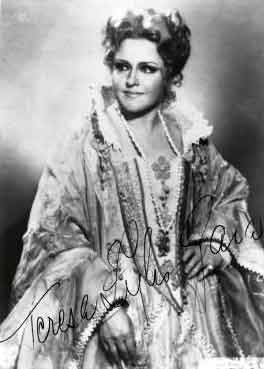 ZYLIS-GARA Teresa - Polish ZYLIS-GARA Teresa - Polish
Violetta (1965). Met 1968: Elvira, Anna Bolena, Elsa. Paris: Cio-Cio San.
Isolde: Wishes to sing Isolde.
At the side of Her who conquered this Valhalla of the lyrical chain accessible via the North Face only and from where the heart wanders through the immensity of Love, how to ignore the cohorts of exhausted sherpas putting up the camp ever higher before the ultimate assault on a peak which opens the Sky so deeply that, seen from below, and from now on, History and Legend merge.
At the side
of Her who conquered
this Valhalla of the lyrical chain
accessible via the North Face only
and from where the heart
wanders through the immensity of Love,
how to ignore the cohorts of exhausted sherpas
putting up the camp ever higher
before the ultimate assault on a peak
which opens the Sky so deeply
that, seen from below,
and from now on,
History and Legend merge.
|
![]()
![]() - https://www.monsegur-vaillant.com/bio/2017.php
*https://www.monsegur-vaillant.com/bio/2017.php
- https://www.monsegur-vaillant.com/bio/2017.php
*https://www.monsegur-vaillant.com/bio/2017.php